#walt ‧̥̥‧̥̥͙ child writing stories of when they become king
Explore tagged Tumblr posts
Text
Okay, disclaimer here. I can't really call myself a true fan of Disney's Wish, just as it is. I do think the film had a LOT of really good ideas and I do think that a lot of artists and creative types put sincere work into it -- I mean, all one really has to do is look at the Wish art book to see that the creators wanted to salute a lot of Disney's overall legacy with their work. However the result turned out -- and I personally found it a bit half-baked with a lot of story and character elements that just didn't quite come together for me -- I like the overall concept enough that I've really enjoyed seeing the fandom embrace those good ideas and reinterpret them. I like the art people have started doing based on Star's old designs by artists like Brittney Lee. I like people writing drafts with villainous-couple-goals Amaya and Magnifico. I like people envisioning Asha as becoming a fairy godmother more in the vein of Whitney Houston's version of the Fairy Godmother in the 1998 Rodger's and Hammerstein's Cinderella! So everything I'm going to write here is from a place of sincerely wanting to add onto the original concept and perhaps improve on it, rather than just out of a desire to make petty pot-shots at the film.
With this out of the way, let me get to the crux of it.
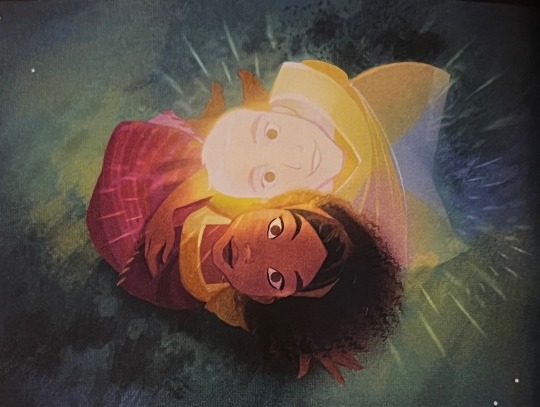
(concept art by Brittney Lee, found in Disney's The Art of Wish)
Now of course people have discussed the concept of Star as a love interest for Asha before. And I won't lie, I do think it's cute! It could even offer a great potential for diversity if Star remained androgynous gender-wise, the way they are in the finished film. Honestly, even having a completely mute leading character and love interest throughout the entire picture would undoubtedly be a unique and special challenge for any animator and storyteller...and for those people who want to evoke old Disney projects, it would prove a great opportunity to build on the legacies of voiceless Disney characters like Dumbo, Bambi, and Tinker Bell, while still adding a new twist in the form of this character being magical and therefore being able to express their feelings not just through colors and body language like Tink does, but perhaps also through the instrumental score! You could embody the whole core of Fantasia -- a passion project of Uncle Walt's that he never saw appreciated in his lifetime but is widely considered to be a masterpiece of animation and music -- in one character!
This leads nicely into another tack this could've played into -- the idea that Star could be an embodiment of Golden/Silver Age Disney, while Asha embodies Renaissance/Revival Disney. Star could be endlessly optimistic and a bit naive, but strangely resilient -- something that seems fragile and helpless at first glance until you realize just how many people and creatures alike gravitate toward them and want to help and protect them. Meanwhile Asha could be all about proving herself -- she could want to become a powerful magician and do great things like her master King Magnifico, but lack confidence in her own abilities and feel isolated thanks to how much her service to and desire to honor Magnifico has isolated her from others.
Star would be Snow White to Asha's Tiana. The Aurora to her Mulan. The Tinker Bell to Asha's Elsa. The bright star to Asha's cool, thoughtful night.
And this is what I love most about this idea -- their relationship wouldn't need to be romantic. It could be platonic. It could be romance-adjacent. Or, if one wants to really go and do something different for a Disney movie...Star could be a child. A mute, sweet, brand-new star, one just born, that responded to a wish that Asha made when she thought no one could hear -- a wish she has trouble admitting to anyone, especially her mentor and toxic father figure, King Magnifico -- because as much as she plays contentment, there is a part of Asha deep down that wants something more. That remembers the loving embrace of her deceased parents and how much Magnifico can't quite capture that warmth and nurturing, however tight his hold might be and placating his words might be. And out of that wish is born this little bundle of stardust, which Asha is now suddenly responsible for and wants desperately to hide and protect from Magnifico.
In essence, Asha would be put in the same position that Willow is put in, when he suddenly becomes the caretaker for baby Elora in the film Willow.

Now that would change up the context for At All Costs, wouldn't it? This lullaby-like song would resonate awfully well in a story where Magnifico sees Asha as an apprentice and almost surrogate daughter and wants to "protect" her a la Mother Gothel by controlling everything in her life, while Asha sees this new Star who's now reliant on her and feels this strange, new desire to protect them from the man who filled the role of her father after his death in a selfless way that man could never understand?
If someone tried to hurt you... I don't see how that could happen! I'd fight for you in ways you can't imagine! Felt this? No, I haven't -- I hope it would be alright to Stay right here beside you...
It would be such a beautiful picture on how love can be both selfish and selfless -- how a villainous person can love, perhaps, but that that love is poisoned by the desire to mold someone into your image and hoard that person away from others who could "take them away" or "change" them...how love at its truest core is selflessness and fighting on behalf of others, to give them a world where they could live safely. And again, this could be either in a scenario where Star is Asha's "child" or her peer -- for a world can't be safe for all if anyone is under threat because of who we are. And Asha, Star, and Rosas all deserve to know true happiness, not just mindless, complacent contentment -- the happiness that can come from the birth of ideas we never thought possible, until we're given the freedom to dream and dream big.
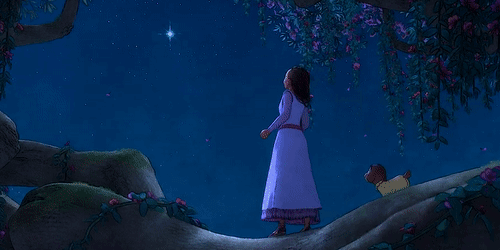
15 notes
·
View notes
Text
Walter smiled tightly, flexing his hands beside his coffee cup. “Are we going to talk business or have you called me out here to just sit and look pretty?”

18 notes
·
View notes
Photo
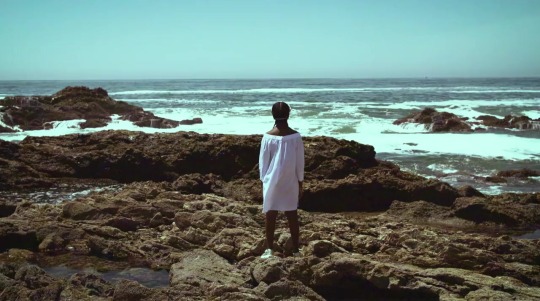

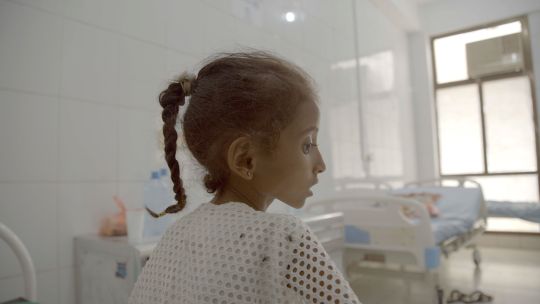

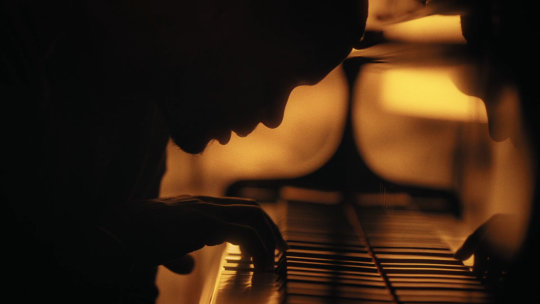
Best Documentary Short Film Nominees for the 93rd Academy Awards (2021, listed in order of appearance in the shorts package)
NOTE: For viewers in the United States (continental U.S., Alaska, and Hawai’i) who would like to watch the Oscar-nominated short film packages, click here. For virtual cinemas, you can purchase the packages individually or all three at once. You can find info about reopened theaters that are playing the packages in that link. Because moviegoing carries risks at this time, please remember to follow health and safety guidelines as outlined by your local, regional, and national health guidelines.
A Love Song for Latasha (2019)
On March 16, 1991, Latasha Harlins, a 15-year-old African-American girl, was murdered by Soon Ja Du at Du’s convenience store in Los Angeles. The murder, which occurred almost two weeks after Rodney King’s beating at the hands of the Los Angeles Police Department (LAPD), contributed to the start of the 1992 LA riots one year later. Directed by Sophia Nahli Allison, A Love Song for Latasha is an avant grade film that intercuts statements by Latasha’s friends and family about the young girl they cared deeply for. Alongside reenacted scenes of childhood, of black girls frolicking on the Californian coastline and the streets of Los Angeles, the film serves as an intimate eulogy for Latasha – one delivered as memories about her become less immediate.
Whatever justified rage the Los Angeles rioters might have felt in 1992 is not the dominant force in Allison’s film. A Love Song for Latasha is foremost a cinematic lament rather than a political polemic. With the reenacted scenes edited and appearing as if it resembling a home movie, this piece appears like a visualization of the memories that the interviewees are recalling. When Latasha was murdered, she ceased to be just a daughter or a friend. A Love Song for Latasha, thirty years on, seeks to reclaim those distinctions for those who knew her best – something, given the significance of Latasha’s murder in history, that may never happen.
My rating: 6.5/10
Do Not Split (2020, Norway)
From Norwegian documentarian-journalist Anders Hammer comes Do Not Split, a street-level glimpse into the protests against the 2019 Extradition Law Amendment Bill (ELAB) that inspired the passage of the 2020 Hong Kong national security law. The events depicted in Hammer’s film include the Hong Kong police’s sieges of the Chinese University of Hong Kong (CUHK) and Hong Kong Polytechnic University, in addition to small-scale clashes between protesters and police, as well as mainland Chinese instigating confrontations. Hammer’s footage is harrowing material, a collection of violent imagery with few moments of individual revelation or introspection outside of the presence of Michigan-born activist Joey Siu. Do Not Split decides not to attempt a dialectic of why the Chinese Communist Party (CCP) and the Hong Kong Legislative Council (LegCo) are pursuing these changes and are brutalizing the protesters, depriving this film of the context that less knowledgeable viewers might need. For those who have been keeping at least superficially aware of events in Hong Kong, there is never any question on which side Hammer is on – despite Hammer’s journalistic background, this is not a piece of objective journalism.
Yet this is not agitprop due to the politics left mostly unexplained, and none of Do Not Split’s flaws take away from the rawness of the protesters’ desperation and the cynicism of the police and government officials enacting the crackdown. Despite the repetitive nature of the footage by the time it reaches the final stages of its thirty-five-minute runtime, Do Not Split contains excellent, crisp hand-held footage that makes immediate sense of the space and time of the depicted violence.
My rating: 8/10
Hunger Ward (2020)
For Pluto TV (some cord-cutting television service I was not familiar with until I started writing this) and MTV Films and directed by Skye Fitzgerald (2018 Oscar-nominated short film Lifeboat), Hunger Ward follows doctor Aida Al-sadeeq and nurse Mekkia Mahdi as they treat malnourished children in the midst of ongoing the Yemeni famine. The famine, directly related to the civil war that began in late 2014, has seen almost a hundred thousand children die in what UNICEF describes as, “the largest humanitarian crisis in the world.” Fitzgerald film works best when focusing on Al-sadeeq and Mahdi, as they describe the heartbreak conditions of the hunger ward and their experiences since the famine began. However, much of Hunger Ward’s footage is too in-your-face with footage of the mothers’ grieving and the last moments of several children. It appears almost as if gawking at the desperation and death that occurs every day in this hospital.
This is not to say that there is no revelation in the image of a child with their eyes glazed in lifelessness or the unearthly wails of a mother overtaken by grief. Fitzgerald edits and shoots their film in a way that makes this process – a child in their last moments of care, a declaration of death, a shot of the child’s corpse, a cut to the mother inside or arriving to the deathbed, and the echoing despair – occur tediously in their movie. Hunger Ward never breaks from this tedious formula. The film is redeemed only by withholding its slings and arrows until some text prior to the end credits, correctly assigning responsibility with Western nations that have enabled and abetted the violence in Yemen.
My rating: 6/10
Colette (2020)
Colette Marin-Catherine is in her twilight years and, upon first appearances, one might not predict the incredible life story that she has to tell. She was a French Resistance member, and French Resistance narratives tend to be sidelined in favor of those depicting Allied soldiers liberating France instead. But Anthony Giacchino’s (the brother of composer Michael Giacchino) film, distributed by British newspaper The Guardian and made for an extra feature of the virtual reality (VR) video game Medal of Honor: Above and Beyond, decides to linger on the memories of Colette’s murdered brother, who died at Mittelbau-Dora concentration camp in Germany, instead. At the urging and with the assistance of the young historian Lucie Fouble, who is interested in telling Colette’s story (although technically this is not Colette’s story), Colette travels to Germany to visit the site of Mittelbau-Dora so that Colette can… spill out her feelings?
It is self-evident that Colette does not see the academic or personal value of such a trip, but the irascible subject of this short film will nevertheless humor Fouble – her intentions genuine, her approach questionable. Colette, who cannot forget the loss of brother but has not been dwelling on his death, is emotionally vulnerable throughout the trip to Germany, and the audience learns little about Colette, German atrocities, or her brother. Even in these moments, she remains a compelling figure on-screen, but this movie is a disservice to its eponymous subject – one who deserves more credit as a member of the French Resistance, as someone not defined by the worst thing that had ever happened to her.
My rating: 6/10
A Concerto Is a Conversation (2020)
Distributed by The New York Times and executive produced by Ava DuVernay, Ben Proudfoot and Kris Bower direct a deeply personal documentary short film to bookend this slate of five. A Concerto Is a Conversation contains a conversation between Kris Bowers (composer on 2018’s Green Book and 2021’s The United States vs. Billie Holiday) and his grandfather, Horace Bowers Sr., before the premiere of Bower’s concerto at the Walt Disney Concert Hall in Los Angeles. What follows is a disjointed film with sketches of Jim Crow-era America from Horace’s past to the anxiety-laden self-questioning of Kris’ present. Kris, as a black man, is questioning his place in the classical music world – which has, justifiably in some ways, been seen as staid and white. If A Concerto Is Not a Conversation can bridge the differences between Horace and Kris’ stories, it barely does so thank to the scattershot editing.
Yet Kris and Horace’s conversation is wholesome, admiring, loving. This is Kris’ way to show his appreciation for his grandfather and the struggles that he endured for most of his life. The out-of-focus background makes A Concerto Is Not a Conversation seem almost like a dream, a meeting that almost should not be happening. And in honoring Kris’ profession and the piece that is set to debut, the film is divided into noticeable thirds – just like a concerto’s three movements. A Concerto Is Not a Conversation might not make for the most cohesive viewing, but it is a celebration of a profound bond, tied together by forces that defy even the most eloquent words: music and love.
My rating: 6.5/10
^ All ratings based on my personal imdb rating. Half-points are always rounded down. My interpretation of that ratings system can be found in the “Ratings system” page on my blog (as of July 1, 2020, tumblr is not permitting certain posts with links to appear on tag pages, so I cannot provide the URL).
For more of my reviews tagged “My Movie Odyssey”, check out the tag of the same name on my blog.
From previous years: 88th Academy Awards (2016), 89th (2017), 90th (2018), 91st (2019) and 92nd (2020).
#A Love Song for Latasha#Do Not Split#Hunger Ward#Colette#A Concerto Is a Conversation#Sophia Nahli Allison#Anders Hammer#Skye Fitzgerald#Michael Shueuerman#Anthony Giacchino#Ben Proudfoot#Kris Bowers#Latasha Harlins#Hong Kong#Yemen#Ava DuVernay#93rd Academy Awards#Oscars#31 Days of Oscar#My Movie Odyssey
16 notes
·
View notes
Text
Kay, so I found this old story idea I had a while back but never really did anything with, and I figured hey, I've got 300+ prisoners beloved followers who for some reason put up with my garbage, so might as well inflict this upon them.
That being said, welcome to what I call The Department for the Colonisation of Childhood Whimsey.
So our story starts with a little girl called Dee.
Dee lives in the UK, in a council estate. When she was a kid, there wasn't all that much space to play or do the things richer middle-class kids got to do. Her parents house didn't have a garden, the local streets were too dangerous for a child to go out and play in, and the house itself was cramped and crowded.
Despite this, Dee had what could charitably be called an overactive imagination, an imagination she channelled into two things: a plastic triceratops toy she called Sarah, and a book - a blank book of A4 paper that had coffee stains on it and papers falling out when she got it - that she claimed had a magical power: anything written in the book would come true.
Cut to a few years later. Dee is in high school, and like a typical teenager she's moved on from her childish dreams. That is, until one day when Sarah the triceratops approaches her after school and tells her she's in danger.
So, yeah, pretty basic beginning, you've probably seen fifty books that start out like this, and that's all I wrote back when I was actually trying to make this a thing. However, one thing I always do vis-a-vis my writing style is worldbuild, and it's the worldbuilding that I'm really keen on with this idea. So, let's talk about that:
The actual premise of the story is simple: at some point in the 1960s, the British government came to the conclusion that the British Empire was more or less doomed. Not only was the post-war economy not capable of sustaining an empire, not only was the Cold War between the Americans and the Russians ravaging them, but an increased awareness of the plight of one's fellow man was inspiring many people - not just in the colonies but in England too - to demand independence. No matter how hard they tried, Parliament could not forsee a solution that the people would accept where the British Empire continued.
So, a solution was posed. For the past hundred years or so, the government had been made aware of the existence of pockets of space-time created by people with active enough imaginations. From Neverland to Oz, from the Hundred Acre Wood to Wonderland, these places had resources beyond any place on Earth - magic, especially. If the public would not countenance colonisation where they could see it, then perhaps the solution would be to colonise somewhere they could not see?
Thus, the British Empire never really died. It simply... moved.
Cut to the present day, and the Department for the Colonisation of Childhood Whimsey is still going strong. Almost every parallel world is under their control, and the profits of these regions are beyond belief. However, rather naturally for stories like this there is a resistance movement, that seeks to free the imaginary lands from the Department. Although they are small and weak, they have had several worthwhile victories over the Department in the past few months, and the higher-ups in the Department, including the shadowy and little-seen Director, want all such resistance movements stamped out.
This, rather naturally, is where Dee steps in.
Every generation, one in a million people have the ability to shape the forces of Imagination itself, and the stories these people tell, and others tell after them, become reality in the Imaginarium. These people become known as Imagineers, and Dee is one such person. However, the lack of much real output for this power has led to most of it being placed inside The Book, which has led to a fascinating feedback loop - Dee's Book not only influences the Imaginarium, it influences physical reality itself to a certain extent. Thus, the Department need simply write in the book that the resistance movement does not exist, and it will be so. The resistance, naturally enough, are not down with this, and have sent Dee's childhood friend to bring her and the book back to them, to keep them safe.
There's also a ton of other small worldbuilding touches I came up with, chief among them being the thing the Department sends to collect Dee - a Stalker, the amalgamation of that seemingly universal childhood experience of that thing that followed your car on long journeys. But a couple of words on the characters:
The leader of the resistance is Peter Pan, because of course he is, why wouldn't he be? He's much more of the capricious, vaguely fae Pan of the book, not exactly evil but very much ammoral and childish. He's mainly invested in reclaiming Neverland, the Lost Boys, and Tinkerbell, although there is the subtext of him using the Department as an example of the inevitable consequences of growing up - although he's completely forgotten Hook, like he does in the book, he's still looking for that antagonistic relationship with a grown-up.
Peter's second-in-command and the one really running the resistance is Princess Ozma, who's much more... agreeable than Pan. Oz has been colonised too, but Ozma is still in nominal control of it, and she supplies the resistance with all the resources she can, although she can't openly work against the Department because the CIA branch of it has Dorothy imprisoned and are basically pulling a 'we have your wife' scenario on her.
The third key player in the resistance is Alice Liddel, who provides the resistance with shelter and safe passage - the Department has been having little success applying the logic of supply chains and regimented exterminations to a place as willfully chaotic as Wonderland.
The rest of the resistance are mainly heroic characters from other public domain stories, although some of the heroes are working for the Department, either willingly or because they're coerced, but one of the other main characters - and Dee's eventual love interest - is a character called many things, but most commonly Insert.
Insert is... complicated. Like the Stalker, they're an amalgamation of a certain new-fangled trend - namely, they're every self-insert character that's ever been written. Naturally, they have a habit of... changing, at random intervals. On any given day, they're any gender, of any ethnicity, of any sexual orientation, and with backstories ranging from an officer on a starship in the far future to a student at a school of magic in Scotland. Given literally everything about them is eternally mutable - including their allegiance to the resistance or the Department - the resistance members treat them with some distrust, a distrust that Dee generally doesn't share. Their relationship is pretty rocky at first - Dee thinks Insert is only interested in her because she can use The Book to give them a concrete identity, Insert is angrt when she reveals this because the constant shifting is just who they are, they don't want to be bound down, and later on there is a genuine dilemma of whether or not Insert is interested in Dee by their own choice or because she's clearly the protagonist and a key part of their identity in a lot of their lives is to be shipped with the protagonist. Also, obvious joke but at several points Insert turns into Ebony Dark'ness Dementia Raven Way, because of course they do.
The Department's side isn't that interesting - it's a whole load of villains, some of the more... problematique heroes, and a few hundred grunts. The most interesting character is The Director. He's never seen, even by the highest ranking members of the Department, and no-one knows anything about him other than his gender. Everyone in the resistance has a different theory of who he is - Pan has a suspicion he may have faced him before, Ozma thinks its the Nome King, Alice the Jabberwocky, and Insert fluctuates, as is their nature, although the top two choices are Voldemort or Dumbledore.
It's Dee, however, who figures out the truth, when captured by the Department. The others couldn't possibly know him, but Dee's heard his voice before, in her history classes.
The Director of the Department is Winston Churchill, made immortal by the collective consensus of him as The War-Time Leader. Unfortunately for the whitewashers of history, the immortal they created isn't the brave fighter of tyranny, but the actual Churchill, warts and all, the man who starved over two million Indians out of spite and neglectfulness. Dee being a descendant of Indian immigrants, this meeting isn't perhaps the best one.
There are side effects to the Director's immortality, however. Since the perception of Churchill is tied so deeply to his speeches, to the voice on the radio, that's all he is now. He wants The Book to give him back a body again, and the Department is basically a means to that end.
That's about all I'd concretely plotted out, otherwise I just had random ideas for sequels:
The America Book, where the resistance goes to rescue Dorothy from the CIA version of the Department, which is located under a theme park that is as close to Disneyland as it is possible to be. Naturally, the head of the American Department is Walt Disney's cryogenically frozen head.
The India Book, because a book about British colonialism has got to touch on India at some point. I haven't gotten far in this one, but one idea was that there would be an ongoing war between the native myths and legends - Hindu mythology, the Mahabharata and such - and what is derisively referred to as the 'imports' - namely, the Jungle Book. Again, no idea how this resolves itself, and frankly as a Brit myself I am in no way equipped to tell a story about India, but food for thought.
That's basically it. This isn't a 'here's something to hype up this series' thing - this is an idea I had, I did some thinking about it, but other things happened and I'm kinda splurging this so anyone else who wants to do this idea can pick it up. If you write something like this, feel free to tell me and I'd love to hear about it.
#i write things#technically the point of this is I DON'T write things#but you get the point#peter pan#land of oz#alice in wonderland
5 notes
·
View notes
Text
Okay, Enough With The Live Action/CGI Hybrids - Quill’s Scribbles
So the trailer for the upcoming Sonic The Hedgehog movie came out...
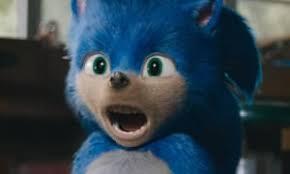
Do I really need to say it? Everyone and their mums have already said it. Hell, you’re probably saying it right now.
Sigh. Okay. Fuck it. I’ll say it.
Who the fuck thought this was a good idea?!?!
The trailer itself is shockingly bad. It looks bland and generic with almost nothing in common with the games. The jokes are forced and painfully unfunny (why are the people in the airport more concerned that the ‘child’ in the bag isn’t James Marsden’s rather than that there’s a fucking child in the bag in the first place?!), Jim Carrey is being his usual obnoxious self and is plain and simply a terrible choice for Doctor Eggman (isn’t the whole point of Doctor Eggman that he’s supposed to, you know, look like an egg?), and the soundtrack is utterly cringeworthy (Gangsta’s Paradise? Really?!?!). But that all pales in comparison to by far and away the biggest problem with the trailer. And I think you can all guess what that is.
Yes I’m of course referring to the noticeable absence of Team Chaotix. An artistic decision so despicable, it’s practically a hate crime. For shame! Everyone knows that Charmy Bee is the best character in the franchise and yet they don’t have the guts to put him in the movie! Fucking philistines!
...
Oh yeah, and Sonic the Hedgehog looks like a monstrous abomination concocted from the fever dreams of Doctor Frankenstein and Walt Disney.
It’s hard to know where to start when talking about just how grotesque and disgusting this CGI Sonic is. He looks like what your computer would produce if it caught pneumonia. What I especially don’t understand is why they veered away so heavily from the original, iconic design. I mean...

I don’t know about you, but I’d honestly have no problem if the movie just kept this look from the games. Hell, I think even giving him realistic fur would be pushing it. This is perfectly fine. I could totally see this design working in a movie. Instead we get the secret love child of Gollum and Papa Smurf.
He just looks so weird with human proportions. The leg muscles, the two eyes, the human looking teeth. Apparently the filmmakers wanted this Sonic to look as realistic as possible. Because when I pay to see a movie about an anthropomorphic blue hedgehog that can run at supersonic speeds, that’s my first thought. ‘Is it realistic?’
... Jesus Christ.
But of course the main problem with this live action Sonic movie is that it exists in the first place. When it was first announced, I assumed in my naivety that it would be an animated movie. Because that would make sense, right? There have been movie and TV adaptations before and they were all animated. Imagine a big budget computer animated Sonic movie. That would be really cool. But it was not to be. In Hollywood’s infinite wisdom, they decided to go the live action route because... Actually why did they choose to go the live action route? Well that’s what I hope to address in this very Scribble.
Live action adaptations and remakes are nothing new of course. Disney had tried it a few times in the past with movies like 101 Dalmations, there have been other live action versions of animated or illustrated characters such as the Grinch and the Cat In The Hat, Garfield, the Smurfs and Alvin and the Chipmunks, and there was of course the infamous Super Mario Bros movie, which answered the question of what it would be like if the Mushroom Kingdom took place in the same universe as Judge Dredd. But this is the first time live action/CGI hybrids have been huge money spinners. Disney struck gold back in 2010 when Tim Burton’s version of Alice In Wonderland made a billion dollars at the box office and now the company is mining through their back catalogue of Disney classics and giving all their movies the live action treatment. Initially I was okay with this because in the case of Alice In Wonderland and Maleficent they were at least trying to reinterpret the original films and put a new spin on them, but now they just seem to be copying the movies verbatim. Making live action remakes just for the sake of making live action remakes.
Now other studios are trying their hand at, the most notable being Pokemon: Detective Pikachu. Here’s a picture of the original Pikachu:

Cute, right?
Now here’s a picture of the live action Pikachu:
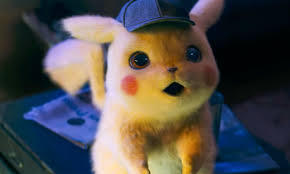
Can you see the problem here?
(also why the hell is Ryan Reynolds the voice of Pikachu? I honestly can’t think of anyone more inappropriate for the role. It’s like casting Samuel L. Jackson as a Powerpuff Girl)
The fact of the matter is some things just don’t work in live action. Sonic the Hedgehog and Pokemon work in their respective universes because they’re animated creatures in an animated world, and their anatomy and design fit that world. In the real world, it just doesn’t work. Pikachu looks strange and kind of creepy in the real world. The same is true of the other Pokemon. Jigglypuff looks utterly adorable in the games and animated show with its spherical body and cartoon eyes and you just want to take one to bed with you and cuddle them like a teddy bear, but in the real world it looks fucking scary!
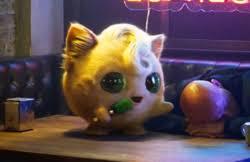
I wouldn’t want to cuddle that thing! It looks like it would go for my throat given the opportunity!
The same is true of Sonic. Paramount’s attempts to make him look more ‘realistic’ just makes him look incredibly alien and out of place.
Another example I like to bring up is the film Christopher Robin. Now we all know Winnie the Pooh. Silly ol’ bear. Charming, cuddly and endearing, right? Just look at him.
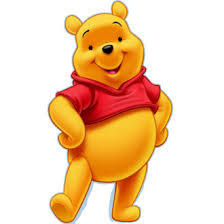
How can you not fall in love with him?
Now here’s the live action version:
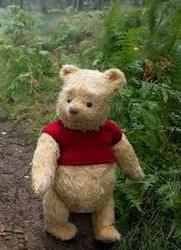
When I first saw the trailer, I was utterly creeped out. He looks like something out of a horror movie. Add to that that they got the original voice actor from the Disney cartoons to reprise the role, and Winnie the Pooh pretty much became the source of all my nightmares for the next couple of weeks. That lovable voice should not be coming out of that... thing.
It’s a pattern that repeats itself over and over again. Look:
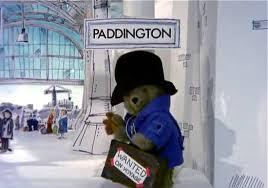
Charming and lovable.
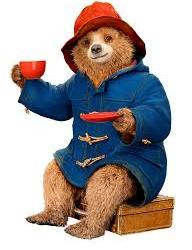
Weird and unsettling.
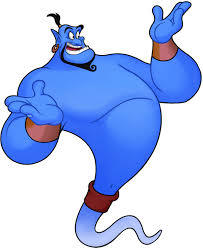
Creative and fun.
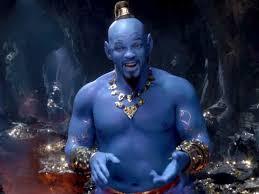
Photoshop disaster.
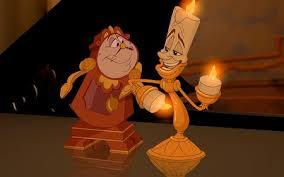
Sweet and likeable.
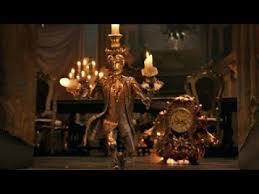
Fetch my crucifix and holy water.

Emotional and expressive.
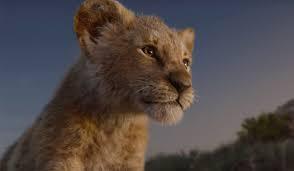
So ‘realistic’ to the point where he looks like he has the emotional range of a teaspoon.
Now I recognise this largely comes down to subjective opinion. If you like these CGI redesigns, that’s great. More power to you. But I know for a fact I’m not the only one getting increasingly weirded out by these computer generated demons from Hell.
So why does Hollywood keep making these films. Well obviously in the case of Disney it’s because they’ve ran out of original ideas and want to make a quick buck by exploiting their audience’s nostalgia. (the same can be said of the Star Wars sequel trilogy). But what about other studios? Yes they’re financially motivated too, but there’s got to be more to it than that.
I think it’s largely down to the stigma of animated movies. Animation has become synonymous with children. When you hear the term ‘animated movie’, you automatically associate it with ‘kid’s film’. And ‘kid’s film’ is often used in a negative context. Like it’s somehow lesser than quote/unquote ‘proper’ movies. Live action suggests a certain pedigree. A sense of prestige. But that’s obviously bollocks. The quality of a film isn’t dictated by whether it’s live action or animated. It’s determined by the writing, directing and acting. There have been live action films made for kids and animated films made for adults. And I’m not talking about Sausage Party. I’m talking about Finding Nemo.
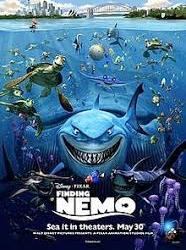
Now I know what you’re thinking. Finding Nemo? Isn’t that a kid’s film? No. It’s a family film. And that right there is the problem. You heard me say Finding Nemo, an animated film about talking fish, and you automatically associated it with a kids film. But the thing is Finding Nemo deals with some very dark and adult themes and its moral message of not being overprotective and allowing children to take risks is intended for the parents, not the kids. Obviously kids can still watch and enjoy Finding Nemo, but it’s the parents who are clearly the target here. The same is true of Toy Story 3. Children can still watch and enjoy it, but the film is clearly intended for people who watched the original Toy Story when they were a kid and are now grown up. When you stop and think about it, it’s really sad that family movies are associated with kids movies. Not that there’s anything wrong with kids movies obviously. But why do people assume that family movies are meant for kids? Why can’t they be adult stories that are also accessible to children? Books have done it. The Artemis Fowl series is kid friendly, but its tone, themes and style suggest the author has an older and more sophisticated target audience in mind. A Series Of Unfortunate Events is popular with kids, but it’s adults that get the full experience because of the way Lemony Snicket uses postmodern and meta-textual elements in the books, which would sail clean over the head of a kid reading it. The idea that a live action remake is somehow more ‘grown-up’ than an animated movie is just absurd. The original Lion King was very grown up, thank you very much. There are lots of bright colours and fun songs for the kids, but it also doesn’t sugarcoat the darker themes such as death, betrayal, corruption and abuse of power. Mufaser’s death isn’t going to be made any more impactful in live action. The animated version was more than heartbreaking.
Shifting the conversation back to Sonic, this is also intrinsically linked with another problem with Hollywood at the moment. Movie adaptations of video games. And again, it’s a similar problem. People, especially critics, view video games as being lesser than movies. Roger Ebert famously said that video games will never be considered art. But that’s nonsense. There have been loads of video games that could be and have been considered art. BioShock, for instance, which scrutinises and criticises both objectivism and capitalism. There’s the Mass Effect trilogy, which is often described as this generation’s Star Wars. The Last Of Us is widely considered to be a masterpiece by gamers and literacy scholars alike. Hell, the fact that Hollywood wants to make movie adaptations of video games at all suggests that games do in fact have some inherent artistic value after all. And it’s not as if I’m wholly against making movies based on video games. There are some games that could translate really well to films, Sonic being one of them. (I personally loved the Ratchet & Clank movie, for example. It’s just a shame nobody else fucking watched it due to the almost non-existent marketing). However there’s an inherent problem with translating video games to movies as opposed to, say, translating books to movies. In book to movies adaptations, studios are adding something. Visuals, sound, performance, etc. In video game to movie adaptations, they have to take things away. The most obvious is interactivity. Unlike movies where nothing is required of the audience other than to just dumbly stare at the screen, video games require the audience to actively control the story. Move the character, kill baddies, solve problems and stay alive. You are an active participant in the narrative. As a result, the emotional connection you feel with both the plot and the characters is often stronger than that in a movie because you have direct influence over what happens.
Also video games have the luxury of being able to tell their stories over the course of eight to thirty to even a hundred hours of gameplay. There’s no way you could condense something like The Last Of Us down to a two and a half hour movie. There would just be too much lost. Important character moments and plot points that would have to be chucked in the bin. Yes things get lost in book to movie adaptations, but nowhere near at the scale of a game to movie adaptation. A possible workaround would be to make game to TV adaptations instead, but then we’re back to the interactivity problem again. And don’t get me wrong, I’m not saying that movies are better than books or that video games are better than movies. I’m just saying they’re each individually suited to tell their own kinds of stories in their own unique ways, therefore translating from one medium to the other is often difficult. The Last Of Us would never make a good movie, and that’s okay. The game is still amazing and the story is still amazing. Its artistic merit isn’t lessened because it can’t be translated to films, in the same way the merits of a bike aren’t lessened because it can’t fly. It’s just not designed to do that.
I guess the point I’m making is there’s no one way to tell a good story. There are an infinite number of ways it can be done. So lets stop Hollywood’s obsession with pigeonholing everything into one format and actually explore the possibilities, shall we?
#sonic the hedgehog#sonic the hedgehog movie#live action cgi remakes#video game movie adaptations#quill's scribbles
21 notes
·
View notes
Text
Thoughts from my recent LOST re-watch
There is absolutely no coherence to this, so please forgive me. It’s just a very long list of all of the random thoughts I’ve had throughout my re-watch of LOST about my opinions on characters, ships, plot lines etc. and how they’ve changed or stayed the same. Feel free to send me an ask if you want me to expand on any of these points.
Season 1 is perfection. Literal perfection. I can’t find a single criticism for it. The mystery, the suspense, the anticipation, the characterisation, the plot, the build-up. Just everything. It doesn’t matter how many times I watch it, it’s still so impactful and the pilot is one of the best pilots of any show I’ve ever seen
It’s still so funny that all of the characters so happen to have the perfect combination of skills to survive - Jack the Doctor, Locke the Hunter, Sayid the Soldier and Kate the Tracker
I always knew it anyway, but the Jack/Kate/Sawyer triangle really is awful. And the fact that they (attempted) to bring Ana Lucia into it and then actually did bring Juliet in to make it a love square is even worse.
Jack and Juliet actually kind of make sense as a romantic pairing and have good chemistry (but Suliet still rule all)
Kate is the worst character on the show. I’m sorry, I’ve tried to like her but I never have. She doesn’t undergo any development until around the time she gets Aaron in season 5 - she kills her father in cold blood and justifies it by saying he was a violent drunk (hello, there’s nothing that can justify murder with maybe the exception of self defence), she then goes on the run where she constantly lies, schemes and manipulates to get what she wants, which ultimately leads to her best friend getting killed in the crossfire. From the second she lands on the island she consistently plays Sawyer and Jack off one another by taking advantage of their feelings for her without any consideration to how that impacts them
John Locke is an asshole a majority of the time and I really don’t like him (this doesn’t include pre-island and flash-sideways John, who’s a sweetheart)
Charlie Pace is also an asshole and I don’t know how I didn’t see this sooner
I’ll never be over Boone’s death or the fact that he died for nothing because of Locke
Walt getting taken from the raft is still one of the most shocking and haunting moments of the series
Hugo Reyes is the definition of cinnamon roll, I love him with every fibre of my being and LOST wouldn’t be what is is without him
Kate treats Sawyer like shit from the beginning and he deserves so much better. I’m not gonna lie, I still don’t understand how or why Sawyer falls in love with her
Also what is that bullshit with them having sex in the cage? I know it’s supposed to be this hot-we-could-die-at-any-moment raw sex but it just comes across as very weird?? Even if they don’t know there’s cameras on them, they’re outside in the open where anybody could see them at any time
Shannon is a very misunderstood character who deserved better. So. much. better.
I still hate Ben, but he’s one of the best written villains in television I’ve ever seen
Charlie/Claire is the worst romance in the world. They have no chemistry, Charlie develops an obsession with her and practically stalks her, forces her to do what he wants her to do, constantly tries to take over with Aaron despite having absolutely no right to. There is just nothing even remotely redeeming about this ship and I still don’t get it
Locke’s musical theme makes me cry every single time
And following on from that, as much as I dislike Locke, his flashbacks always make me cry. “Don’t tell me what I can’t do, ever!”, when he gets in the wheelchair in the hospital after his father has pushed him out of the window and when he cries in the car after his father tells him he’s not wanted. It’s heartbreaking
I still can’t get over all the amazing character connections - Charlie saving Nadia, Sayid meeting Kate’s father and Kelvin during the war, Jack meeting Desmond before the island, Christian being Claire’s father, Christian and Ana Lucia going to Australia together, Sawyer meeting Christian in the bar etc. - it’s all so beautifully done in a way that feels authentic and links the characters (even the ones with more superficial ties) together so well
Michael is not a bad person and is unfairly hated. He’s just a father that did what any parent would do to keep their child safe
Hurley and Libby are sweet but severely underdeveloped
I actually really dig the episode about Paulo and Nikki
Eko has such a touching and emotional arc, which although short, is very well rounded
The Other 48 Days is still one of the most chilling episodes of the series
It’s sad that the Tailies were all killed off so prematurely, I feel like they all had potential to be more
Jin’s development is so unappreciated. He’s probably the character that goes through the most amount of growth from the pilot to the finale
I know I should feel sorry for Claire (and part of me does), but I still find her too annoying to feel anything but dislike for her
Desmond and Penny’s love story is freakin’ beautiful and nothing can compare
Also how cute are Rose and Bernard? I’ve come to appreciate their relationship so much. They’re literally just two people who love each other in the purest way and want to be together. It’s so beautiful
Sayid is one of the best characters on the show and my love for him has been reaffirmed
I understand the appeal of Sayid and Shannon but Nadia was Sayid’s soul mate and no one can tell me otherwise
Jack is probably the most unstable character on the show but it’s never acknowledged
Am I the only one that notices that Charlie flat-out lies about not being able to swim? In season 1 when Joanna is drowning Charlie tells Jack he can’t go in to help her because he can’t swim, but he consistently dreams about swimming to save Aaron, Desmond has a vision of him saving Claire from drowning and in season 2 he flat out tells everyone he’s swimming junior champion and swims down to the Looking Glass. Is this Charlie being a liar or simply a fault of the writers, I wonder?
The episode where Sawyer, Jin and Hurley fix up the Dharma car still makes me so happy
Sun and Jin’s relationship is one of the best developed fictional ships I’ve ever seen. It’s so rare that we actually get to see a married couple who are on the verge of breaking up actually love each other enough to work their asses off to make it work and end up being happier and more in love with each other more than ever before
The Others are still absolutely terrifying in seasons 1 and 2 before we find out who they are
Charlie and Hurley’s friendship is overrated
Adding to that some underrated dynamics are - Sayid and Desmond (in The Constant Sayid blindly does everything in his power to help Desmond despite not understanding what the hell is going on with him), Kate and Sayid, Hurley and Sayid, Michael, Sawyer and Jin, Shannon and Walt, Boone and Shannon, Eko and Ana.
Jack is by far the most flawed protagonist I’ve seen in any show
I’m intrigued to know what direction Ana Lucia’s character would’ve gone in if she’d survived
The musical themes are still the best of any show I’ve ever seen. I love that each character has their own theme which perfectly encapsulates them
The way that everyone just forgets about Claire after she goes missing and don’t even attempt to find her is so bad. Particularly when you consider the fact that whenever anyone else has gone missing or were kidnapped - Jack, Kate, Michael, Hurley - they’ve gone on a rescue mission immediately
I’ve always been indifferent to Sun but I realise now that I don’t like her. She’s very hard to connect with and in the last seasons she becomes completely irrelevant and has no personality what-so-ever
Jack reacts so coldly to finding out that Claire is his sister. Like he finds out, he’s shocked, has tears in his eyes but nothing changes in how he behaves and thinks about Claire and Aaron, which makes no sense (but I’m glad we got to see this explored in the Flash Sideways)
Danielle and Alex Rousseau deserved better. So much better
All these people that accuse the show of having an abundance of plot-holes just aren’t paying attention or want everything to be spoon fed to them. There’s actually only about 1 or 2 inconsistencies big enough to be considered a plot-hole (the main one being that Danielle actually sees Ben face-to-face when he kidnaps Alex, but later on doesn’t recognise him when she captures him in a net) and everything is tied together perfectly
I didn’t realise before but season 5 is actually a pretty bad season. The most redeeming aspect is Suliet
Did anyone else notice that Naveen’s (Sayid) accent regresses into his own English accent in season 5 and 6?
I actually hate the entire concept of Jacob and the MIB and what was done with them
Jack really does become Locke in seasons 5 and 6
Following on from that, I really can’t blame Sawyer for wanting to murder Jack in season 5/6. He saunters back onto the island like he’s King of the Island thinking he’s some hero who’s going to save everyone he left behind whilst also fixing himself without any consideration to the repercussions. He completely destroys the life Sawyer and Juliet have spent 3 damn years building which results in a lot of people dying, including Juliet and he doesn’t even really seem that aware of how badly he’s fucked up
We were robbed of a Frank Lapidus centric episode and flashbacks. Robbed, I tell you
I love Jack and Kate as a ship, but when they get back to the island in season 5 they’re very OOC (which is a writing problem imo). Kate wanders off and leaves Jack behind all the time and they don’t really stick together which is just not like Jack and Kate at all. No matter what they always stick together
Sawyer’s character development is amazing. I love him so much
The Temple is dumb. The concept of it, the people we’re introduced to - everything. It should’ve just been scrapped
I also don’t understand what the hell happens to Sayid when he’s drowned in The Temple???? It’s so random and inconsistent, it makes no sense
I still love the concept of the Flash Sideways and don’t understand how people can hate on it or claim it doesn’t matter. It’s so important in so many ways
But I still don’t quite understand why Jack and Juliet have a son in the Flash Sideways? I understand why Jack has a son, because it makes sense for him to work out his ‘daddy issues’, but I don’t understand why Juliet is the mother and what the significance is of that
We really should’ve got more Desmond centric episodes
The Constant is still one of the best episodes of television ever made
The older I get the more I understand and appreciate the religious and theological meanings of the show
I still don’t understand how or why Hurley starts being able to see ghosts. Like that ability just comes out of no where with little to no explanation
It also gets very confusing trying to distinguish between literal ghosts and when the MIB has taken on a dead person’s form
I understand now that one of the many reasons LOST speaks to me on a personal level, and always has, is that I too have felt lost (both metaphorically and literally) throughout my life and I’m able to connect to every character on that basis regardless of whether I like them or not
The characterisation on this show is still second to none. The way each character has distinct lives that are fully fleshed out by flashbacks and that we get to understand every intimate detail about them - the worst thing they’ve ever done, their happiest moment, their greatest fear, the person they love most - I’m yet to find another show that writes its characters in such a complex and fulfilling way
I will always love the show and stand by it being one of the best shows ever, but as the seasons progress it does decline in quality, especially seasons 5 and 6
The finale is still perfect though. I cry like a baby every single time - the church, the way Jack cries in his dad’s arms, it’s just too much
#lost#lost meta#mine#my meta#no one will read this but i wanted to just get all my thoughts/feelings down as i was watching#cos everytime i do a rewatch i see different things or my opinions/feelings change about certain characters/ships/plots etc#text post
12 notes
·
View notes
Text
Amanda Gorman calls on Americans to 'leave behind a country better than the one we were left' in powerful inauguration poem
New Post has been published on https://appradab.com/amanda-gorman-calls-on-americans-to-leave-behind-a-country-better-than-the-one-we-were-left-in-powerful-inauguration-poem/
Amanda Gorman calls on Americans to 'leave behind a country better than the one we were left' in powerful inauguration poem
Speaking at a US Capitol that just two weeks ago was the site of a harrowing attempt to overthrow American democracy, Gorman bridged the violence of January 6 with the anguish felt by so many Americans of color but described the country as ready to begin anew under President Joe Biden.
“We’ve seen a force that would shatter our nation rather than share it,” the 22-year-old Gorman said, a reference to the deadly insurrection that, as she told Appradab last week, was a catalyzing inspiration for her poem. “Would destroy our country if it meant delaying democracy. And this effort very nearly succeeded. But while democracy can be periodically delayed, it can never be permanently defeated.”
Clad in a yellow coat and punctuating her words with her hands, Gorman nodded not only to the perilous political moment but also the history and promise of a day on which Kamala Harris became the first woman, first Black person and the first South Asian to be elected vice president of the US.
“Somehow we’ve weathered and witnessed a nation that isn’t broken, but simply unfinished. We, the successors of a country and a time where a skinny Black girl descended from slaves and raised by a single mother can dream of becoming President, only to find herself reciting for one,” the 22-year-old Gorman said in her poem, entitled, “The Hill We Climb.”
“We’ve seen a force that would shatter our nation rather than share it,” Gorman recited, a reference to the deadly insurrection at the US Capitol that, as she told Appradab last week, was a catalyzing inspiration for her poem. “Would destroy our country if it meant delaying democracy. And this effort very nearly succeeded. But while democracy can be periodically delayed, it can never be permanently defeated.”
Gorman, who regularly draws from current political events in her work, spoke passionately Wednesday about the need for social change: “We learned that quiet isn’t always peace, and the norms and notions of what ‘just is’ isn’t always justice.”
“We are striving to forge our union with purpose. To compose a country committed to all cultures, colors, characters and conditions of man,” Gorman said. “And so we lift our gaze, not to what stands between us, but what stands before us. We close the divide because we know to put our future first, we must first put our differences aside. We lay down our arms so we can reach out our arms to one another. We seek harm to none and harmony for all.”
Gorman was wearing a ring with a caged bird, which was symbolic of Maya Angelou, who wrote “I Know Why the Caged Bird Sings” and recited a poem at President Bill Clinton’s first inauguration. The ring was a gift from none other than Oprah Winfrey, the young poet revealed on Twitter Wednesday afternoon.
Born and raised in Los Angeles by a single-mother and 6th-grade English teacher, Gorman started writing poems when she was a child, but found it terrifying to perform due to a speech impediment. She overcame that fear by drawing confidence from former President Barack Obama and Martin Luther King Jr., and practices songs from the Broadway musical “Hamilton.”
She previously told Appradab that she drew inspiration for the poem from the two poems read at Barack Obama’s inauguration — Richard Blanco’s 2013 “One Today” and Elizabeth Alexander’s 2009 “Praise Song for the Day” — and writers, like Walt Whitman and Frederick Douglass, whom she feels have spoken to the ideals of a nation.
She was halfway through writing the inauguration poem when she saw the Capitol riot, and she previously told Appradab she would attempt to “communicate a message of joining together and crossing divides.”
This story has been updated with additional comments and background information.
Appradab’s Veronica Stracqualursi contributed to this report.
0 notes
Video
youtube
The Wonderful World of Disney Rare Cartoon Oddities
This might be the most fun I have had making one of these episodes, If you read below you will find out a lot of pretty deep info in the Disney folklore world, these lost cartoons have really quite a history!
The Wonderful World of Disney was a show that bought America and the world a rare glimpse behind the scenes of the greatest animation studio on earth. Walt Disney, each week, would talk about rare cartoon oddities, interesting life lessons or even the antics of Professor Ludwig Von Duck and his favorite cartoon character Donald Duck (his favorite was Donald Duck not his original character Micky Mouse believe it or not!) You may have seen some of this collection before, but not restored to the original 3 color Technicolor standards and not in Ultra Stereo, only the Original Cartoon Crazys professionals can bring you!
Today, animation historian Thomas R Reich PhD pulls back the curtain on 5 unique and rarely scene pieces of classic animation. These cartoons are rare oddities because Disney Studios has stopped officerly showing or releasing them for various reason. Many know to the WW2 cartoon made for the US Government Spirit of 43 to get American workers to save more money and invest in the war effort through War Bonds, we have that restored for you here today. But more rare is the earlier US Government PSA New Spirit, which again stared Donald Duck, the the subject was paying your individual oncome tax on time! This does not seem ground braking today, but in 1942, this was a new concept, in fact income tax was a new concept, and citizens were not paying up. Walt Disney and his artists found a way to guilt the public into paying in droves with the magic of Disney animation.
Then we get into the really obscure, but also very beautiful lost animation of the 1930's. We restored "Micky's Surprise Party" where Minnie Mouse was trying to bake a surprise for Micky but failed measurably in the kitchen. All would have been lost until Micky shows up with many delicious Nabisco backed goods products and even doggy baskets for Pluto. Minnie even has her dog right out of Lady and the Tramp (even though this cartoon predates Lady and the Tramp by 8 years). All becomes clear when you realize this was the official film made for the Nabisco exabit in the 1939 New York Worlds Fair, and Wald Disney's first true entry onto the world stage of commercial promotion.
Another interesting rescue from the obscure pile of lost rarities is Pluto starring in his own short cartoon called "A Feather in His Collar" made for The Community Chest, to encourage donations. It is a heart warming story of Pluto going into his treasured stash of dog bones and giving a generous share to The Community Chest to help out the community.
Then we come to a really rare and beautiful cartoon called "A Cowboy Needs a Horse" and this is a very interesting back-story to be sure. When cartoon of the 1050's had the intro "Walt Disney Presents" it was a signal to reviewers that this was a test for a possible animated movie. Walt had an idea for a Western teamed cartoon movie about a child who falls asleep and dreamed all sorts of cowboy adventures before asking safe in his bed the next morning. Sounds just right for the 1950's and indeed even Pixarish plot wise. I mean Cowboy and Indian movies and TV shows were king well into the early 1960's then died abruptly in about 1965. Walt was a genius for predicting markets, and since this test came out in the late 1950's, with pre=production writing, more tests, storyboarding, then the actual production of the animated full length film, it would not be ready for release until the mid-1960's. He must have seen the end of the Cowboy craze coming because this beautiful cartoon was shelved and the idea of the film abandoned forever.
It could have been Walt Disney's heavy involvement in all aspects of the troubled 1964 New York Worlds Fair, which he saw as the future of the Disney organization and the "test" for whether the new Disney World on the east coast could work. It is probable that no one will ever know for sure, but we have resorted this masterpiece to all its original Technicolor beauty and rich Ultra Stereo sound for the first time ever here for you today.
Enjoy all these restored rarities, I promised you new restorations beyond the original catalogue of 477 animated shorts and 7 full length movies of the origional Cartoon Crazy. This new collection "The Wonderful World of Disney Rare Cartoon Oddities" of proof of that.
There will be 2 more rare Disney Cartoon Oddities shows in this series so subscribe and hit the bell to make sure you see them first!
I enjoy doing all this for you so much! Thomas R Reich PhD Cartoon Crazy
0 notes
Text
On Frozen 2 and Disney’s nostalgia problem
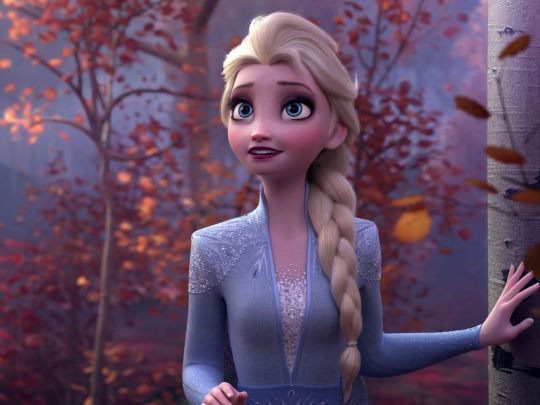
Elsa’s back. | Walt Disney Pictures
Disney used to always be looking forward. These days, it increasingly only looks back.
Nobody was more nostalgic than Marcel Proust.
The French novelist’s six-volume masterwork In Search of Lost Time is narrated by a man who’s remembering his youth, and it explores how strange and unreliable memory can be. Throughout the series, the notion of “involuntary” memory is a recurring theme, but it’s particularly important in the famous “madeleine” scene.
The scene comes early in the first volume, Swann’s Way, when the taste of a madeleine dipped in tea immediately plunges the narrator into a vivid childhood memory. It’s so well-known that it remains a cultural reference point even today, more than a century after Swann’s Way was published: To say that something is your “madeleine” is shorthand for any sensory experience that brings back a flood of childhood memories (even though mounting evidence suggests that Proust’s version may have just been soggy toast).
That sensory experiences can trigger powerful memories, particularly of youth and childhood, was not a particularly earth-shattering insight on Proust’s part — lots of people have had similar episodes. And while not all of his narrator’s recollections are fond, a lot of them seem presented through a haze of affection — the reliability of which, as the narrator us himself, is a little suspect. “Remembrance of things past is not necessarily the remembrance of things as they were,” he writes.

Maurice Rougemont/Gamma-Rapho/Getty Images
Marcel Proust famously wrote about madeleines as he explored the ways our memories are triggered.
Proust aptly describes the concept of nostalgia: a sentimental yearning for the past, which Merriam Webster defines, succinctly and evocatively, as “the state of being homesick.” And while we periodically recall certain moments as being worse than they actually were (I think of the 30 Rock episode in which Liz Lemon is shocked to discover that her memories of being bullied in high school are faulty, and she was the one doing the bullying), the past often takes on a rosy hue.
Time, distance, and the occasional dash of willful ignorance are effective modifiers. They’re why societies collectively hallucinate Golden Ages, and why so many people find the idea of making America “great again” appealing. It’s less about conserving the good of the past, and more about rejecting the present.
Nostalgia is not, as a mood, inherently bad. Sometimes, feeling a bit homesick is good. But when that feeling becomes our default posture, our guiding light, it starts to become ... troubling? Inhibiting, maybe? Stifling? If the past was when things were good, why bother to build a new future? Better to just keep reinventing the past.
Which brings us to Disney, and to Frozen 2.
Disney used to be a company that looked forward. These days, it seems more interested in looking back.
Disney now controls the lion’s share of the movie industry. In 2019 so far, five of the six highest-grossing films worldwide have been Disney properties; the sixth (Spider-Man: Far From Home) was a joint endeavor between Sony and Disney-owned Marvel. The company’s reach is staggering: It owns, among scores other entities, Pixar, the Marvel Cinematic Universe, Star Wars, and as of earlier this year, the film and TV assets formerly held by 21st Century Fox — in addition to its own extensive and much-beloved back catalog, lots of which is now available to stream via the just-launched Disney+ service.
Disney is in the entertainment business. But what it’s selling isn’t entertainment, exactly — that’s just the vehicle for its real product, and that product has shifted and morphed over time. At one time, a big part of what Disney was selling was a vision of a utopian future, as you know, if you’ve been to Tomorrowland or Epcot at Walt Disney World.
In his speech at the opening day of Disneyland in 1955, Walt Disney himself pointed to his vision of the park as a place where nostalgia and forward-looking inspiration could coexist: “Here age relives fond memories of the past, and here youth may savor the challenge and promise of the future.”
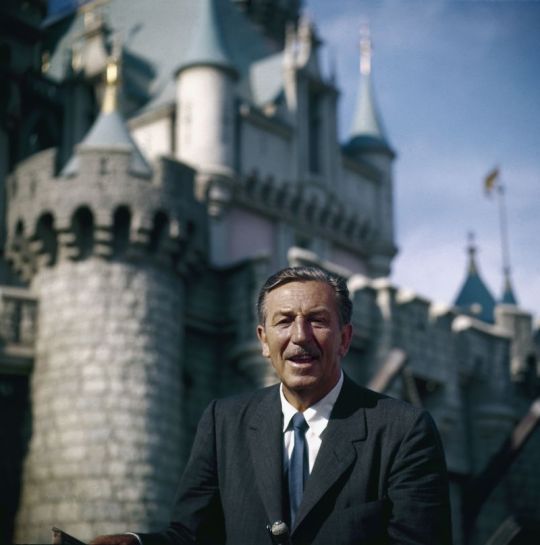
Allan Grant/The LIFE Picture Collection via Getty Images
Walt Disney at the Disneyland grand opening in 1955.
But as we come to the end of this banner year for Disney, it’s clear that what the company wants to sell us, going forward, is a seemingly infinite heap of Proustian madeleines. Certainly the warm fuzzies have been one of Disney’s main exports for a long time, but some kind of tipping point was reached in 2019. Now, it seems evident that Disney sees provoking existential homesickness as its main job. Nostalgia is its real product.
Consider Toy Story 4, the fourth film in a series that debuted in November 1995. If you were 8 years old and saw Toy Story in theaters when it opened, you might have brought your own 8-year-old to see the new film earlier this year.
That’s a remarkable stretch of time, and the Toy Story series has stayed remarkably thematically coherent over that time. It’s a set of stories about the passage of time, about how nothing stays the same, about the fact that kids grow up and leave home — that’s why Toy Story 3 left parents bawling when Andy finally grew up and didn’t need his toys anymore. The toys, in a sense, are the parents’ stand-ins. And Toy Story 4, in which some of the toys opt to live a child-free life, feels an awful lot like a movie about being an empty nester, something that could render a parent munching popcorn with their third grader a bit verklempt, thinking about their own now-empty-nester parents who once took them to see Toy Story.
That’s the good kind of nostalgia. And the Toy Story series has successfully refreshed its basic premise over two decades — toys get lost, toys get found — in part through its willingness to surprise viewers, to crack jokes and be a little creepy and think outside the (toy) box with its narratives. So when we find ourselves feeling homesick, in a story about the passage of time, it works.
I think of this approach as generative nostalgia. It’s a way for Disney to use memory, to tap into the audience’s particular madeleines, to bolster the storytelling itself (and make an enormous wad of cash, too). Not every attempt lands, but when movie studios try to tap into nostalgia in order to generate fresh new stories with universal themes, to get creative with the familiar, it’s a good thing for art.
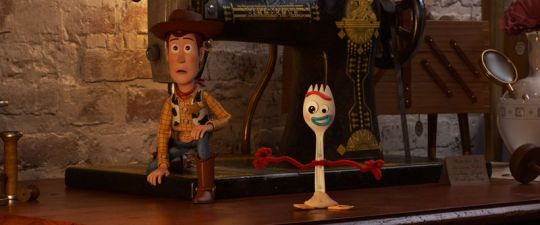
Pixar Animation Studios / Walt Disney Pictures
From Toy Story 4, we got Forky.
If Toy Story 4 was an example of Disney harnessing generative nostalgia, however, its so-called “live-action” remake of The Lion King was just the opposite. The film was never meant to be a standalone movie; its success was always fully dependent on the long-entrenched popularity of the 1994 animated film it recreates, in some cases shot for shot. It’s an entirely unnecessary movie — a way for Disney to test-drive high-end, lifelike CGI and get people to pay for it. And without the imaginative, sometimes visually wild artwork of the original, it falls very flat, with no new perspective on its source material.
Call it derivative nostalgia: For most audiences, The Lion King and Disney’s other live-action remakes (Aladdin was another huge hit this year) are interesting only insofar as they promise to deliver a (slightly) new spin on a beloved classic, without straying too far. We still get “Can You Feel the Love Tonight,” but it’s Donald Glover and Beyoncé. A copy of the original with some of the details tweaked. That’s the appeal.
And while derivative nostalgia has its place — we rewatch our favorite movies for a reason, because we like the feelings and memories they provoke — Disney seems intent on adopting it as a modus operandi, judging from the number of remakes the company has announced. It will depend on the built-in audience of people who loved Lady and the Tramp or 101 Dalmatians to pony up for a ticket or subscribe to Disney+ and ensure these projects’ success.
But I’m convinced the urge to use your giant piles of money to endlessly replicate the past can’t be good for a culture. Certainly, human culture is cumulative; we’re always building on what came before. For millennia, storytellers have leaned on the same material, like myths and archetypes, to find new ways to tell stories. But derivative nostalgia stymies the creative impulse, miring us in the same thing over and over again and training audiences to demand the predictable. Vanilla pudding tastes good, but there’s a lot more to food than vanilla pudding.
You can witness the battle for Disney’s soul happening inside Frozen 2
These generative and derivative modes of nostalgia seem to be warring inside inside Frozen 2, which is pleasing and enjoyable even if it’s clearly designed to function as an ATM for Disney, with Frozen’s previously established fanbase acting as the bank account behind the screen. It is, thank God, no Olaf’s Frozen Adventure.
The Frozen films are aimed primarily at little girls and boys, of course — Disney’s long-running core constituency for stories about princesses and talking animals (or snowmen). But, given that the first movie came out six years ago, Frozen 2 is also for older kids. And one of the most notable things about the movie is that it’s also for their parents.
Perhaps following Pixar’s lead, the more traditional Disney Animation studio has caught onto the fact that if you want grown-ups to be happy when they take kids to the movie theater, you’ve got to make something they’ll enjoy, too. So Frozen 2 leans (more noticeably than its predecessor) into jokes the adults will appreciate, and one in particular: While the kids at my screening howled at Olaf’s slapsticky misadventures, the adults were the ones laughing as Princess Anna’s hunky boyfriend Kristoff crooned his very ’80s-sounding power ballad “Lost in the Woods.”
During a recent interview, Josh Gad (who voices Olaf) joked that the song “speaks to all of us that grew up in the ’80s.” And he’s totally right. The voice of Kristoff, Jonathan Groff, says he was surprised when the song was handed to him: “I couldn’t believe that they were going to go there,” he said, calling it “truly shocking” and later saying it has the energy of Michael Bolton. The song is about how much Kristoff needs Anna in his life; in the film, he sings it during a fantasy sequence of finding her, backed by a chorus of singing reindeer. (The official Frozen 2 soundtrack includes a version of the song by Weezer, which kind of says everything.)
As Gad pointed out, it’s definitely a sight gag for the olds in the room — the younger Gen X and older millennial parents who’ve come to see Frozen 2 with their kids, and are now being rewarded with their own extended musical joke. What’s funny about it is that the musical-style “Into the Woods” parodies was already ridiculous by the time most gen-Xers and millennials became adults; what we’re reminded of now is the sheer goofiness that was so prevalent back then, when romantic ballads were sung by guys with bad hair surrounded by unironic kitsch.
Kids born in the 21st century won’t get the joke. But Frozen 2 isn’t exclusively for them; it’s for 20th-century kids, too. In fact, though its action is set just three years after the end of Frozen, it is, like Toy Story, about the passage of time, and what it’s like to grow older. Olaf sings a song about how things don’t make sense to him now, but they will someday; Anna and Olaf reflect on how they hope everything will stay the same, even though — spoiler alert — of course, they won’t.
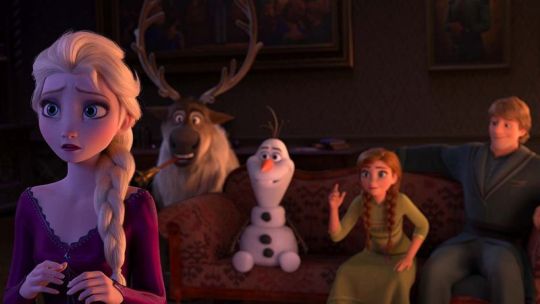
Walt Disney Pictures
The gang’s all back together in Frozen 2.
So Frozen 2 provokes all kinds of nostalgia. For kids who’ve already spent years dressing up as Anna and Elsa and driving their parents to distraction with “Let It Go,” the new film is a return to the happy land of Arendelle, where they’ve had many adventures. For teenagers who saw the original Frozen when they were 8 or so, but are now in high school, it’s a reminder of how far they’ve come. And for adults, it tugs on decades-old heartstrings — not just the chuckling memory of’ 80s power ballads, which might be the madeleine that reminds some of dancing at prom, but also the Disney princess stories so many of us grew up watching.
Whereas the original Frozen is a bit of an odd film — its plot structure feels a little out-of-sync with Disney’s usual storytelling, and its “true love’s kiss” comes not from a prince but a sister — Frozen 2 is much more conventional. Frozen retained some of the eerie strangeness of the Hans Christian Andersen fairy tale it was (very) loosely based on; Frozen 2 goes back to the usual adventure-and-return structure that has made so many classic Disney movies a success. It’s familiar. It’s comfortable.
By my lights, Frozen 2 is still a plenty enjoyable film, even if it lacks its predecessor’s subversive spark. But for me, watching generative and derivative nostalgia spar within it prompted a different sense of the familiar: bleakness about the future of mouse-eared entertainment. Disney, whatever its faults, has often been a pioneer in storytelling; now it’s resting firmly on its laurels, too often electing to spin the wheel again rather than try to reinvent it.
Nostalgia has its place. Remembering the feeling of homesickness reminds us where we came from, that we come from somewhere. But too much yearning for the past without a concomitant attempt to live in the present and push toward the future is a dangerous trap for a culture to fall into, both because it risks becoming stagnant in its art and because it may begin to to worship the past as the only place worth living in. Too much yearning for the past makes us incurious about the world. And if, as Proust wrote, the past we remember is not necessarily the one that existed, remaining stubbornly beholden to it can render us altogether incapable of dealing with the present.
The bigger Disney gets, the more it controls what most Americans — and people around the world — will see at the movies and on their TV screens, and thus it bears enormous responsibility for seeing into the future. Looking backward too much, recycling old content and relying on old formulas endlessly, becomes a snake eating its own tail.
As the endless stream of reboots and remakes and sequels and revivals that currently dominates entertainment attests, nostalgia sells. But it is also the thing most easily packaged to sell. Recycling content is the low-hanging fruit. And when Disney leans into the least creative sort of recycled content, live-action remakes — something nobody’s really asking for — it’s signaling how little it’s interested in originality.
Even when those remakes take a risk — for instance, by casting black actress Halle Bailey as Ariel in The Little Mermaid — it’s worth noting how safe the “risk” really is. Being a creative leader who celebrates inclusivity means daring to build something new, and trusting the artists to draw audiences into a new story. It doesn’t mean casting new faces in old, well-trodden roles with guaranteed built-in audiences because you’re not sure audiences will turn up otherwise. It doesn’t mean defaulting to reviving your past.
Which, ironically, is something Walt Disney was determined to keep his company from doing. As quoted in the 2007 Disney animated film Meet the Robinsons, he pushed for just the opposite: “Around here, however, we don’t look backwards for very long. We keep moving forward, opening up new doors and doing new things, because we’re curious. And curiosity keeps leading us down new paths.”
Frozen 2 opens in theaters on November 21.
from Vox - All https://ift.tt/2OvMLXf
1 note
·
View note
Text
D-Views: The Hunchback of Notre Dame
Bonjour, mes amies! Welcome, bienvenue, to another installment of D-Views, my written review series for films produced or inspired by the Walt Disney company! For more reviews for films like Enchanted, Star Wars Episode III, and Snow White and the Seven Dwarfs, feel free to consult my “Disney reviews” tag, and please, if you enjoy this review or any of the others, please consider liking and reblogging! I look forward to writing more of these in the future for films like Wreck-It Ralph and Halloweentown, as well as Non-Disney films like Charlotte’s Web.
I recently put out a poll suggesting three Disney Renaissance films for possible review subjects, and although The Little Mermaid won that poll, this film ended up not far behind. (Thank you, @schifty-al and @mygeekcorner for your votes!) It’s one of my personal favorite Disney films of all time...The Hunchback of Notre Dame!

Victor Hugo’s classic novel Notre Dame du Paris, called The Hunchback of Notre Dame in English, seems like a very odd inspiration for a Disney animated family film, and that’s because...yeah, it is! When the Disney animators first brought Hunchback to the table, they were less inspired by the original Hugo novel glamorizing the architecture of Notre Dame cathedral, and more inspired by a graphic novel adaptation of the story, which was likewise much more influenced by the 1939 Hollywood film adaptation. Because of the historical context that 1939 adaptation was made in (premiering at Cannes during the rise of the Third Reich), themes of social justice were added to a story that originally was about how the “edifice” can outlast the flaws and sins of mankind. The “social justice” element is something that Hugo interestingly put more in his follow-up to Notre Dame du Paris, the epic brick book Les Miserables, but has since been similarly tied in the public consciousness to The Hunchback of Notre Dame, despite not existing in the original book.
The project was already an odd choice for Disney to take on thanks to the darkness of the book, but the political themes also were unique for a Disney picture as well. It clearly was a more “adult” endeavor, even though thanks to the success of previous projects like Aladdin and The Lion King, there were studio mandates demanding more comic relief, and even the marketing team was reluctant to advertise Hunchback as anything other than a family film. Rather than showing the artistry and darker scenes, the marketing almost entirely focused on the Feast of Fools and the gargoyles, highlighting the “Ugly Duckling” aspect added to the story and downplaying the more adult themes. In the end, it’s likely thanks to those poor marketing choices and the inconsistent tone of the picture that this movie failed to find its audience on first run. It only earned $21 million worldwide, compared to Pocahontas’s $29 million and The Little Mermaid’s $84 million, with mixed critical and audience reaction. Although it was nominated for an Academy Award for its music and won several others, it was noticeably less successful than other installments in the Disney Renaissance, and even now, Disney often doesn’t give Hunchback that much attention. Like Quasimodo, the film has been sort of locked up in its own tower...but now, today, I aim to bring The Hunchback of Notre Dame out of the shadows and give it the appreciation it deserves.
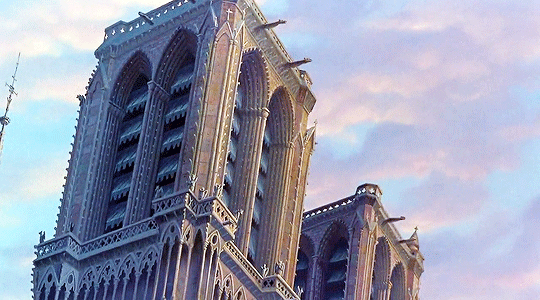
Our film begins in complete darkness, accompanied by resounding church bells and the amazing vocalizations of the English Opera Company, and from the very beginning, I’m just enveloped by the embrace of Alan Menken and Stephen Schwartz’s unbelievable score. Choral music in general has always been something special in my family. My mum and dad were in choirs a lot of their lives: they even first met when they joined the San Diego Master Chorale in the 80′s. Choral music remains one of my mother’s greatest loves and passions, and when I saw Hunchback, it made the choral music my parents loved so much, which focused around a faith I hadn’t been raised with and didn’t believe in, that bit more accessible to me as a child. Mum, who studied Latin in college, went on to teach me about all of the chants and phrases Menken and Schwartz added to each song so that I could more appropriately sing along. It remains one of those Disney soundtracks that cemented our close bond, and I’ll always treasure being able to see the La Jolla Playhouse production of The Hunchback of Notre Dame with my mum and getting to hear the amazing choir and instruments live.
The Bells of Notre Dame, as an opening number, cannot be matched in how it introduces us all to the story, characters, themes, and tone of the piece. In just a few minutes, the music and lyrics perfectly showcases our setting, the theme of what makes a man, the atmosphere of fear and injustice, our villain, and our hero. Menken and Schwartz previously worked together on Pocahontas, but Hunchback in my opinion easily outstrips their previous collaboration. The use of church bells of all sizes to convey the solemnity, mystery, and grandeur of the cathedral at the center of the proceedings, and the clever use of Latin phrases -- it’s just unbelievable! As one example, in the sequence where Frollo (a judge in this version, as opposed to the Archdeacon) chases Quasimodo’s mother up to the stairs of Notre Dame and she pounds on the door, crying for help, the choir sings “Quantus tremor est futurus quando Judex est venturus,” which means, “What trembling is to be when the Judge comes.” And sure enough, the line comes to a horrible, horrified halt when Judge Frollo snatches the woman’s child away and throws her to the ground.
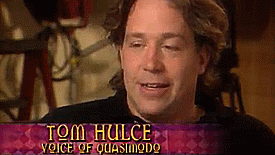
After one of the most epic musical introductions in a Disney film, we meet our sweet, gentle hero, Quasimodo, voiced by Tom Hulce, who is just such a ray of sunshine. Although I loved hearing Michael Arden as Quasimodo on stage, Tom Hulce will always be my Quasimodo. When I was a teenager, I went through a horrible “hating the world” phase where I only ever saw pain and suffering and felt not only powerless to make anything better, but worthless as well. During that time, I turned my back on a lot of the things that had brought me joy, feeling almost unable to enjoy them anymore. One of the very few exceptions, however, was this movie and especially the character of Quasimodo. When I was at my darkest points, Quasimodo never failed to bring me some light, not because he was particularly funny, but because for all of the misery in his circumstances, he never faltered in being gentle, creative, and kind. Looking back on how I’d been, I wish I’d had just a shred of Quasimodo’s grace back then. I wish I hadn’t allowed myself to fall into despair and resentment. Since I can’t go back, however, I keep Quasimodo in my mind sometimes whenever I’m going through something difficult. He’s kind of become a guardian angel of sorts to me, reminding me that my life is a precious gift and I shouldn’t take anything for granted. And really, I couldn’t do that if not for Tom Hulce and Quasimodo’s supervising animator, James Baxter. I truly am grateful to both of them for giving me a character that even now can be a symbol of everything I wish I could be.
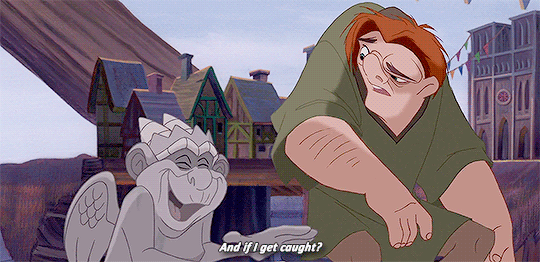
Unfortunately along with Quasimodo, we also meet the gargoyles, Hugo, Victor, and Laverne. As a kid, I actually liked the gargoyles all right, but as an adult...yeah, they really break the mood. Badly. The worst offender is easily Hugo, which is a shame because I like Jason Alexander as a performer, but he just goes way too over-the-top-obnoxious. It would admittedly not be as bad if it were clear that the gargoyles were all in Quasimodo’s head, but Djali sees Hugo come to life at one point and they later help Quasimodo fight off the guards. I greatly prefer the way the gargoyles are handled in the stage production, where all of the saintly statues have their own voices that nonetheless reflect what Quasimodo is thinking and when Quasimodo hits his lowest point before Esmeralda’s execution, he forcefully banishes them out of his head.
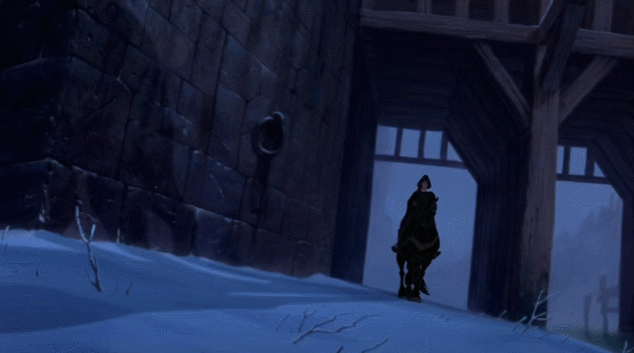
Even though the comic relief is handled poorly, I certainly cannot say the same for the villain. Judge Claude Frollo is easily one of the most evil villains in Disney history. Tony Jay’s vocal performance is just chillingly resonant, commanding your attention and making you subconsciously shrink in on yourself whenever he speaks. It makes for a despicable, cold, cruel man -- the antithesis of a father, the true embodiment of a monster. Frollo is often compared to Mother Gothel from Tangled in how they both lie to, control, and emotionally abuse their charges (Quasimodo and Rapunzel, respectively), but I personally find Frollo so much worse than Gothel, because he not only cuts Quasimodo off from everyone, but he indoctrinates a gentle, kind soul like Quasimodo in his racism and intolerance against those different from him -- including Quasimodo’s own people, the Romani. Mother Gothel hoards Rapunzel away like a dragon hoarding treasure -- Frollo treats Quasimodo like a burden, beating into him that no one else would want him and that Frollo was such a “good man” to take him in. It’s just vile.

And now we come to my single favorite Disney song of all time -- Quasimodo’s aria, Out There. From the time I was little, this song spoke to me like few others did. Growing up, I was an only child with a huge imagination surrounded almost entirely by adults and who had a lot of difficulty relating to kids my age. I often liked being on my own, but it didn’t change how I often felt different and detached from the people around me, and as I got older, that feeling only increased. I moved a lot in my childhood, making it difficult for me to plant roots, and I rarely followed trends or popular norms, so I constantly stayed in the fringes of the crowd, enviously looking on at those who could fit in more easily than I could. I always tried to hide my insecurities, but they were still there, and when those insecurities took hold, I would often imagine the world being a place where I could be myself, just like Quasi does. Quasimodo’s longing to be “part of them” and lamentation of people being “heedless of the gift it is to be them” has always resonated with me, and even though it’s hard for me to sing Out There without shifting octaves, my heart swells every time I hear it.
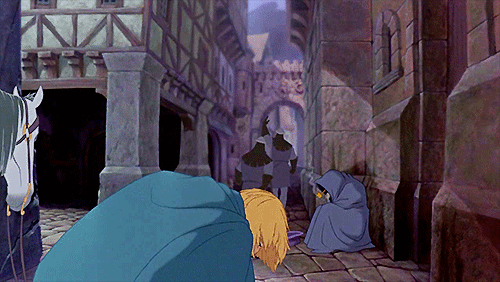
The Captain of the Guard, Phoebus, is easily the biggest liberty that Hunchback adaptations have made with the original novel. The book version of Phoebus was more like Gaston from Beauty and the Beast than how he’s portrayed here, but I frankly have no complaints. Kevin Kline is wonderfully dry and witty in the role -- he’s more than a match for Esmeralda, being brave, noble, and sarcastic with seemingly no prejudice for those different from him. And then yeah, as for Esmeralda herself...as Phoebus says later, “what a woman!” Esmeralda was one of my very favorite Disney heroines as a kid, and she still is. The character of Esmeralda is often rather saint-like in her incarnations, but here we see both the “angelic” and “demonic” sides of her -- she’s fiery, but kind; rebellious, yet noble; anti-authority, but patient; distrustful, yet loyal. In the musical adaptation, when Esmeralda is first revealed, we hear Frollo, Phoebus, and Quasimodo sing this about her --
Frollo: She dances like the Devil!
Phoebus: She dances like an angel --
Quasimodo: An angel!
Phoebus: -- but with such fire!
Frollo: Such fire!
All Three: Who is she?

This is Esmeralda’s characterization and her relationship to the three male main characters in a nutshell. Quasimodo only sees the best of Esmeralda; Frollo only sees the worst of her; and Phoebus sees her for everything she is...as a person. And this is why she ultimately chooses Phoebus, unlike in the book where she solely chooses Phoebus because of his looks.
When we reach the Palace of Justice, I’m reminded that I have yet to accent how absolutely stunning every single background is in this movie. Yes, the animation overall is wonderful, whether in the character animation or otherwise, but there are few Disney films that have more atmospheric and beautiful backgrounds than this. It serves to give the movie such a wonderful depth and makes the setting feel that much richer and deeper. Admittedly one weaker aspect of the animation is the now-slightly-outdated CG background characters. They were made by taking a handful of templates and then mixing up their clothes and colors, so as to multiply them ad infinitum and make the crowds of Paris look bigger and more colorful. Even with that, though, you do sort of have to look carefully at the background crowds to notice, as there are lots of hand-drawn characters sprinkled in in front of those CG models that help obscure their repetition and awkwardness. Those CG crowds also make the city of Paris look appropriately overcrowded and huge, so I’m glad that they used the technology even if it was still so in-progress at the time.
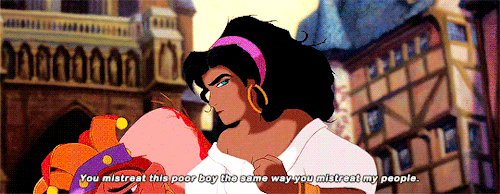
Even though Topsy Turvy starts off so fun and festive, however, it soon devolves into a terrible riot where Quasimodo is bound and tormented by the crowd. I admit, the transition is a little abrupt, but it still works for me, as people can be so easily swept away by mob mentality and those in power -- namely, Frollo’s guards -- sometimes flaunt their authority by putting down others. Fortunately Esmeralda is there to save Quasimodo and give Frollo a much-deserved verbal smackdown. The following scene, though, is another example of the mismatched tone, stretching out Esmeralda’s escape with a lot of comic “hijinks” that don’t really add anything to the film and kind of serve as a big time waster, especially after it abruptly cuts off and turns much more solemn and sad as Frollo silently confronts Quasimodo and Quasi returns to Notre Dame in shame.

Hunchback’s focus on religion is, in my opinion, one of the things that made producing an adaptation of Hugo’s novel such a bold decision. I’m not a religious person at all (Agnostic and proud), but it was still really meaningful to me to see both the good and bad associated with religion, represented by the Archdeacon and Frollo respectively. Frollo, along with Pharaoh Seti from The Prince of Egypt, taught me as a kid that evil is not always self-aware and, more importantly, how much more dangerous evil is when it garbs itself in godliness and righteousness. That’s a valuable lesson, regardless of your religious faith. God Help the Outcasts may invoke God’s name, but it could just as easily be a prayer to the world, or even just to you as an individual. The Christian faith preaches that we are made in God’s image...so when Esmeralda asks God to help her people, maybe she’s in truth asking you to try to be the loving God they need.

Something unique about Hunchback is the wonderful friendship that develops between Esmeralda and Quasimodo. From the time I was very little, I made friends with both boys and girls, so it was so wonderfully refreshing to see a story where a girl and a boy became such close friends and supported each other so much. Yes, admittedly, Quasimodo is romantically interested in Esmeralda, but when he sees how much she loves Phoebus, he both accepts their relationship and treasures Esmeralda’s friendship all the same. He doesn’t wallow in bitterness upon Esmeralda not choosing him; he loves her all the same as the first real friend he’s ever had. Esmeralda truly loves Quasimodo and treasures their friendship too -- her choosing Phoebus romantically is never framed as her teasing Quasimodo or leading him on; she simply loves Phoebus and Quasimodo in different ways. And that I find so unbelievably cool. I also like that in Esmeralda’s and Quasimodo’s conversation on the roof, there are some strains of the deleted song Someday in the instrumental accompanying the scene -- you can hear a R&B variation of Someday in the film’s credits, but originally it was meant to replace the more religious God Help the Outcasts, only for God Help the Outcasts to be chosen over it. I agree with the filmmakers’ decision, but I still like Someday too. Quasimodo’s helping Esmeralda and Djali escape Notre Dame by climbing down the towers also beautifully foreshadows Quasimodo’s dexterity in climbing down to save Esmeralda at the end of the film.

Quasimodo and Frollo are both enthralled with Esmeralda, but as mentioned previously, they each only see the angelic and demonic sides of her, which is best encapsulated by the dual numbers Heaven’s Light and Hellfire. Heaven’s Light is appropriately sweet and pure, but I can’t beat around the bush here: Hellfire steals the show, not just from Heaven’s Light but from all other villain songs in Disney history. The song starts with a choral chant praying for forgiveness, which then segways into Frollo’s demented, mad raving about his lust, fear, and hatred for Esmeralda. The words are almost terrifying in their level of conviction and paranoia, which then devolves into vindictive, destructive mania, framed by the mournful echoes for “mercy” from the choir.
Right after Hellfire, we get one of my favorite instrumentals on the soundtrack called Paris Burning. The choir’s bustling, dramatic cries trimmed by the tense strings and horns of the orchestra just evokes fear and horror as Frollo terrorizes Paris. Then Phoebus finally takes a stand, refusing to set fire to the miller’s house and then, after Frollo does it himself, leaping in to save the family from the flames. In the musical, this whole sequence is accompanied by the amazing musical number Esmeralda (which honestly, every fan of this movie should listen to, it’s really worth it), but the film handles it unbelievably well with only a short scene and an instrumental that sears the final “Kyrie Eleison” into the audience’s ears like a fire brand.
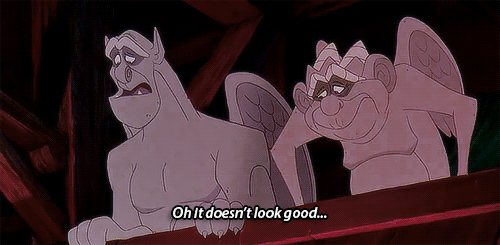
Sadly, after this amazing, epic sequence, we once again are subjected to tonal whiplash when we return to the bell tower and the gargoyles decide to sing Quasimodo a song to cheer him up. Although I maintain Hunchback has one of the best soundtracks ever recorded, what stops it from being flawless is this song. A Guy Like You is not an inherently bad song on its own, but when combined with the rest of the soundtrack, its melody, tone, and out-of-place pop cultural references are just ridiculously jarring. It’s like we’ve been transported into a completely different movie, one less inspired by a classic French novel and a critically acclaimed film about social justice and one more inspired by Disney hits of the day like Aladdin and later projects like Hercules. As sad as it is, it’s kind of a relief when it’s over and we’re brought back down to earth by Esmeralda carrying a close-to-death Phoebus into Quasimodo’s tower.
Frollo’s arrival after Quasimodo agrees to hide Phoebus is excellent in its suspense. We can sense Frollo’s suspicion, and all the while, we’re so worried for Phoebus hiding under the very table he and Quasimodo are sitting at. Then Frollo, who we’ve only ever seen as cold, conniving, and controlled, bursts into a rage the kind of which we’ve never seen before, and for a second, he’s a demon himself. After his rage is spent, he sets his cruelest, most terrible trap yet: using Quasimodo’s feelings for Esmeralda so that he can capture her and the rest of the Romani. And at first, Quasimodo almost doesn’t take the bait, thanks to a short-lived pang of self-pity. At first he’s bitter about his heart being broken and considers not helping Esmeralda, as there’d seemingly be no “reward” in him doing so...but the feeling is quelled in seconds by the memory of Esmeralda and how much her friendship means to him. Quasimodo’s selflessness and goodness wins out in its struggle with his more selfish instincts...and this, in the end, is what makes Quasimodo a hero in my eyes.
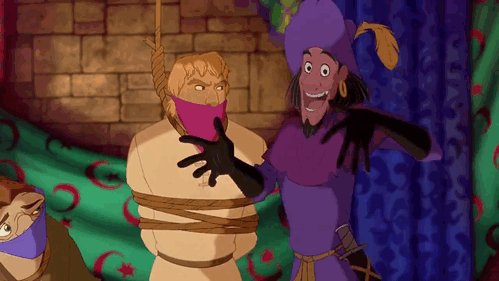
All right, I guess with our entrance into the Court of Miracles, I should address the elephant in the room. I’ve called Esmeralda’s people “the Romani” in this review, but throughout the entire film, the term is substituted for the admittedly-period-appropriate slur “Gypsy.” I knew nothing about the Romani culture when I first saw this film and I profess no intimate knowledge of it now, but even with that, I have to acknowledge that this movie doesn’t always showcase the Romani in the best light. Although Quasimodo’s parents, Esmeralda, and (to a degree) Clopin are given relative sympathy, the sequence in the Court of Miracles doesn’t do much to endear them to the audience. These victims of persecution are not really given the focus they deserve: we never learn much about their culture or about why they’re persecuted, and we don’t really get to see how they live their lives as ordinary people. To someone who doesn’t know anything about the Romani, I don’t think this film would be the best introduction to their culture and heritage.

Our climax is accompanied by the best instrumental track in the film, Sanctuary! Whenever I hear this piece, I have to stay completely silent, drinking in every single line and note, so as to properly absorb its brilliance. The track has accompanied a lot of my writing in the past: it’s always helped me when I was writing a powerful, emotional climax, whether through the emotion it wrought from me or just from wanting to write a new scene to the music. This entire sequence, from a musical, writing, animation, and character point of view, is I think what made Disney decide to make this film in the first place. The pacing -- the character animation of Quasimodo tearing down the pillars -- the drawn backgrounds of Notre Dame -- the camera whirling over the never-ending crowd’s heads and up onto the cathedral as Quasimodo hoists Esmeralda over his head -- this is the heart of why the movie was made and what the entire film was building up to. This resistance against injustice and the protection of our sacred, historical institutions from hatred and cruelty is what Hunchback is and should be all about. Occasionally this battle scene is inter-spliced with comic bits that once again aren’t really necessary and kind of stick out (Laverne’s Wizard of Oz reference and Hugo’s impression of a fighter plane in particular are out of place), but it doesn’t ruin anything for me. Fortunately as the climax grows darker with the arrival of Frollo and the transition from Sanctuary! into And He Shall Smite the Wicked, the gargoyles take a backseat, and we get focus where we should’ve always had it: on Quasimodo, Esmeralda, and Frollo. Thanks to his love for his friend Esmeralda and the realization of his own self-worth, Quasimodo finally stands up to Frollo and breaks free of his poisonous influence once and for all. This line of Quasi’s has always stuck with me --
“All my life you’ve taught me the world is a dark, cruel place...but now I see the only thing dark and cruel about it is people like you!”

Even now this line is just so powerful. There was a point where all I saw of the world was its cruelties and injustices...but like Quasimodo, I’ve come to see that those cruelties are not inherent to the world or even to mankind as a whole. Humans are capable of both great evil and great good, but as long as the evil people of the world are allowed to seize control and exert their toxic influence over everyone else, the world and mankind overall will never become better. Like Quasimodo, we must stand against those who’ve embraced cruelty and hatred over acceptance and love. We must protect the brighter parts of the world that evil so wishes to snuff out. It’s a moral I think has only become more relevant and important over time.
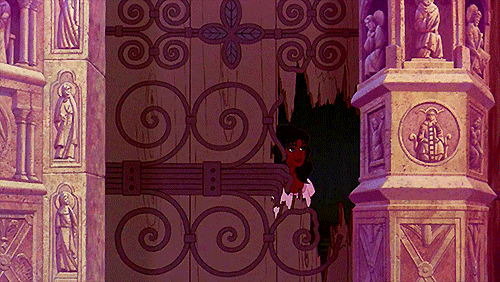
Unlike in the book and musical, Esmeralda survives, and as much as I’ve heard people try to argue Esmeralda living is not true to the spirit of the original novel, I think it really suits the story being told and really feels just for both characters. Quasimodo deserved happiness; Esmeralda deserved happiness; and most importantly, this all the more highlights how different Quasimodo is from Frollo. Frollo says to Esmeralda, “Choose me or the fire” -- basically, if he can’t have her, he doesn’t want anyone else to...but Quasimodo doesn’t think that way. He cherishes Esmeralda and her friendship without any caveats or conditions: therefore him losing Esmeralda, whether to Phoebus or to death, doesn’t prompt him to commit suicide like he did in the novel. It’s not only a more uplifting ending, but I think a lesson in the selflessness of love, even if it’s just platonic love. And because Esmeralda loves Quasimodo just as much as a friend, she leads him out into the sun, where he finds even more of the love he deserves from the city he wished so much to belong in. Quasimodo doesn’t get the girl, but that was never what he wanted in the first place: it was merely to be accepted as he was.
The Hunchback of Notre Dame was one of the most formative films of my childhood, right up there with Beauty and the Beast, The Prince of Egypt, and Anastasia, and it remains my second favorite Disney animated film of all time. With time, I’ve seen more and more of its flaws, but those flaws don’t ruin what in the end is one of the most daring, revolutionary projects Disney Animation has ever tackled. Its artistry, from the backgrounds to the character animation, is exceptional; all of its major human characters are multi-faceted, complex, and real; its themes are eternally relevant and powerful; and its score and nearly all of its songs are just through the stratosphere in their quality. Hunchback, along with Beauty and the Beast, made me fall in love with France from afar as a child, a love affair that has only become more and more intense through the years, and Quasimodo and Esmeralda even now are so close to my heart. I wish so much to be as kind and gentle as Quasimodo and as brave and noble as Esmeralda, and I can only hope that at some point, if I ever visit Disneyland Paris, I might finally meet them. The Hunchback of Notre Dame may not have gotten the appreciation it deserved when it first came to theaters, but I’ll always be happy to hear Disney fans remembering it as fondly as I do. Who knows? Maybe someday, the world will be wiser and will give this film its time in the sun at long last.

#d-views#disney reviews#the hunchback of notre dame#disney#opinion#analysis#reviews#oh boy here i go
18 notes
·
View notes
Text
Closed Starter: @dorcasrises Walt & Dorcas. Yule Ball
“Cousin dearest,’ Walt smiled stiffly, trying to act more sober than he really was. He always felt sort of sad when he saw Dorcas. He liked to think if they’d been born into a less complicated family that they would’ve been closer. He’s always admired her from afar. “I like your outfit, will you be wearing it to the wedding?”

‧̥̥‧̥̥͙
3 notes
·
View notes
Text
On Frozen 2 and Disney’s nostalgia problem
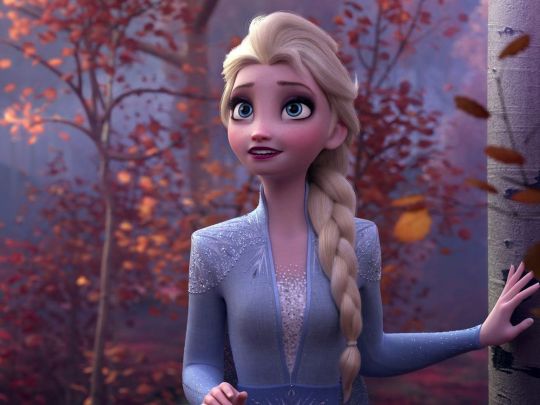
Elsa’s back. | Walt Disney Pictures
Disney used to always be looking forward. These days, it increasingly only looks back.
Nobody was more nostalgic than Marcel Proust.
The French novelist’s six-volume masterwork In Search of Lost Time is narrated by a man who’s remembering his youth, and it explores how strange and unreliable memory can be. Throughout the series, the notion of “involuntary” memory is a recurring theme, but it’s particularly important in the famous “madeleine” scene.
The scene comes early in the first volume, Swann’s Way, when the taste of a madeleine dipped in tea immediately plunges the narrator into a vivid childhood memory. It’s so well-known that it remains a cultural reference point even today, more than a century after Swann’s Way was published: To say that something is your “madeleine” is shorthand for any sensory experience that brings back a flood of childhood memories (even though mounting evidence suggests that Proust’s version may have just been soggy toast).
That sensory experiences can trigger powerful memories, particularly of youth and childhood, was not a particularly earth-shattering insight on Proust’s part — lots of people have had similar episodes. And while not all of his narrator’s recollections are fond, a lot of them seem presented through a haze of affection — the reliability of which, as the narrator us himself, is a little suspect. “Remembrance of things past is not necessarily the remembrance of things as they were,” he writes.

Maurice Rougemont/Gamma-Rapho/Getty Images
Marcel Proust famously wrote about madeleines as he explored the ways our memories are triggered.
Proust aptly describes the concept of nostalgia: a sentimental yearning for the past, which Merriam Webster defines, succinctly and evocatively, as “the state of being homesick.” And while we periodically recall certain moments as being worse than they actually were (I think of the 30 Rock episode in which Liz Lemon is shocked to discover that her memories of being bullied in high school are faulty, and she was the one doing the bullying), the past often takes on a rosy hue.
Time, distance, and the occasional dash of willful ignorance are effective modifiers. They’re why societies collectively hallucinate Golden Ages, and why so many people find the idea of making America “great again” appealing. It’s less about conserving the good of the past, and more about rejecting the present.
Nostalgia is not, as a mood, inherently bad. Sometimes, feeling a bit homesick is good. But when that feeling becomes our default posture, our guiding light, it starts to become ... troubling? Inhibiting, maybe? Stifling? If the past was when things were good, why bother to build a new future? Better to just keep reinventing the past.
Which brings us to Disney, and to Frozen 2.
Disney used to be a company that looked forward. These days, it seems more interested in looking back.
Disney now controls the lion’s share of the movie industry. In 2019 so far, five of the six highest-grossing films worldwide have been Disney properties; the sixth (Spider-Man: Far From Home) was a joint endeavor between Sony and Disney-owned Marvel. The company’s reach is staggering: It owns, among scores other entities, Pixar, the Marvel Cinematic Universe, Star Wars, and as of earlier this year, the film and TV assets formerly held by 21st Century Fox — in addition to its own extensive and much-beloved back catalog, lots of which is now available to stream via the just-launched Disney+ service.
Disney is in the entertainment business. But what it’s selling isn’t entertainment, exactly — that’s just the vehicle for its real product, and that product has shifted and morphed over time. At one time, a big part of what Disney was selling was a vision of a utopian future, as you know, if you’ve been to Tomorrowland or Epcot at Walt Disney World.
In his speech at the opening day of Disneyland in 1955, Walt Disney himself pointed to his vision of the park as a place where nostalgia and forward-looking inspiration could coexist: “Here age relives fond memories of the past, and here youth may savor the challenge and promise of the future.”
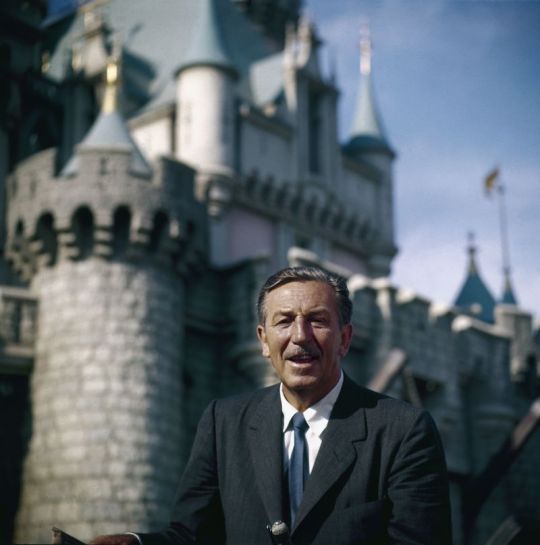
Allan Grant/The LIFE Picture Collection via Getty Images
Walt Disney at the Disneyland grand opening in 1955.
But as we come to the end of this banner year for Disney, it’s clear that what the company wants to sell us, going forward, is a seemingly infinite heap of Proustian madeleines. Certainly the warm fuzzies have been one of Disney’s main exports for a long time, but some kind of tipping point was reached in 2019. Now, it seems evident that Disney sees provoking existential homesickness as its main job. Nostalgia is its real product.
Consider Toy Story 4, the fourth film in a series that debuted in November 1995. If you were 8 years old and saw Toy Story in theaters when it opened, you might have brought your own 8-year-old to see the new film earlier this year.
That’s a remarkable stretch of time, and the Toy Story series has stayed remarkably thematically coherent over that time. It’s a set of stories about the passage of time, about how nothing stays the same, about the fact that kids grow up and leave home — that’s why Toy Story 3 left parents bawling when Andy finally grew up and didn’t need his toys anymore. The toys, in a sense, are the parents’ stand-ins. And Toy Story 4, in which some of the toys opt to live a child-free life, feels an awful lot like a movie about being an empty nester, something that could render a parent munching popcorn with their third grader a bit verklempt, thinking about their own now-empty-nester parents who once took them to see Toy Story.
That’s the good kind of nostalgia. And the Toy Story series has successfully refreshed its basic premise over two decades — toys get lost, toys get found — in part through its willingness to surprise viewers, to crack jokes and be a little creepy and think outside the (toy) box with its narratives. So when we find ourselves feeling homesick, in a story about the passage of time, it works.
I think of this approach as generative nostalgia. It’s a way for Disney to use memory, to tap into the audience’s particular madeleines, to bolster the storytelling itself (and make an enormous wad of cash, too). Not every attempt lands, but when movie studios try to tap into nostalgia in order to generate fresh new stories with universal themes, to get creative with the familiar, it’s a good thing for art.

Pixar Animation Studios / Walt Disney Pictures
From Toy Story 4, we got Forky.
If Toy Story 4 was an example of Disney harnessing generative nostalgia, however, its so-called “live-action” remake of The Lion King was just the opposite. The film was never meant to be a standalone movie; its success was always fully dependent on the long-entrenched popularity of the 1994 animated film it recreates, in some cases shot for shot. It’s an entirely unnecessary movie — a way for Disney to test-drive high-end, lifelike CGI and get people to pay for it. And without the imaginative, sometimes visually wild artwork of the original, it falls very flat, with no new perspective on its source material.
Call it derivative nostalgia: For most audiences, The Lion King and Disney’s other live-action remakes (Aladdin was another huge hit this year) are interesting only insofar as they promise to deliver a (slightly) new spin on a beloved classic, without straying too far. We still get “Can You Feel the Love Tonight,” but it’s Donald Glover and Beyoncé. A copy of the original with some of the details tweaked. That’s the appeal.
And while derivative nostalgia has its place — we rewatch our favorite movies for a reason, because we like the feelings and memories they provoke — Disney seems intent on adopting it as a modus operandi, judging from the number of remakes the company has announced. It will depend on the built-in audience of people who loved Lady and the Tramp or 101 Dalmatians to pony up for a ticket or subscribe to Disney+ and ensure these projects’ success.
But I’m convinced the urge to use your giant piles of money to endlessly replicate the past can’t be good for a culture. Certainly, human culture is cumulative; we’re always building on what came before. For millennia, storytellers have leaned on the same material, like myths and archetypes, to find new ways to tell stories. But derivative nostalgia stymies the creative impulse, miring us in the same thing over and over again and training audiences to demand the predictable. Vanilla pudding tastes good, but there’s a lot more to food than vanilla pudding.
You can witness the battle for Disney’s soul happening inside Frozen 2
These generative and derivative modes of nostalgia seem to be warring inside inside Frozen 2, which is pleasing and enjoyable even if it’s clearly designed to function as an ATM for Disney, with Frozen’s previously established fanbase acting as the bank account behind the screen. It is, thank God, no Olaf’s Frozen Adventure.
The Frozen films are aimed primarily at little girls and boys, of course — Disney’s long-running core constituency for stories about princesses and talking animals (or snowmen). But, given that the first movie came out six years ago, Frozen 2 is also for older kids. And one of the most notable things about the movie is that it’s also for their parents.
Perhaps following Pixar’s lead, the more traditional Disney Animation studio has caught onto the fact that if you want grown-ups to be happy when they take kids to the movie theater, you’ve got to make something they’ll enjoy, too. So Frozen 2 leans (more noticeably than its predecessor) into jokes the adults will appreciate, and one in particular: While the kids at my screening howled at Olaf’s slapsticky misadventures, the adults were the ones laughing as Princess Anna’s hunky boyfriend Kristoff crooned his very ’80s-sounding power ballad “Lost in the Woods.”
During a recent interview, Josh Gad (who voices Olaf) joked that the song “speaks to all of us that grew up in the ’80s.” And he’s totally right. The voice of Kristoff, Jonathan Groff, says he was surprised when the song was handed to him: “I couldn’t believe that they were going to go there,” he said, calling it “truly shocking” and later saying it has the energy of Michael Bolton. The song is about how much Kristoff needs Anna in his life; in the film, he sings it during a fantasy sequence of finding her, backed by a chorus of singing reindeer. (The official Frozen 2 soundtrack includes a version of the song by Weezer, which kind of says everything.)
As Gad pointed out, it’s definitely a sight gag for the olds in the room — the younger Gen X and older millennial parents who’ve come to see Frozen 2 with their kids, and are now being rewarded with their own extended musical joke. What’s funny about it is that the musical-style “Into the Woods” parodies was already ridiculous by the time most gen-Xers and millennials became adults; what we’re reminded of now is the sheer goofiness that was so prevalent back then, when romantic ballads were sung by guys with bad hair surrounded by unironic kitsch.
Kids born in the 21st century won’t get the joke. But Frozen 2 isn’t exclusively for them; it’s for 20th-century kids, too. In fact, though its action is set just three years after the end of Frozen, it is, like Toy Story, about the passage of time, and what it’s like to grow older. Olaf sings a song about how things don’t make sense to him now, but they will someday; Anna and Olaf reflect on how they hope everything will stay the same, even though — spoiler alert — of course, they won’t.
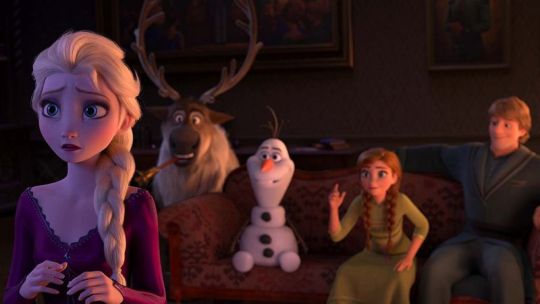
Walt Disney Pictures
The gang’s all back together in Frozen 2.
So Frozen 2 provokes all kinds of nostalgia. For kids who’ve already spent years dressing up as Anna and Elsa and driving their parents to distraction with “Let It Go,” the new film is a return to the happy land of Arendelle, where they’ve had many adventures. For teenagers who saw the original Frozen when they were 8 or so, but are now in high school, it’s a reminder of how far they’ve come. And for adults, it tugs on decades-old heartstrings — not just the chuckling memory of’ 80s power ballads, which might be the madeleine that reminds some of dancing at prom, but also the Disney princess stories so many of us grew up watching.
Whereas the original Frozen is a bit of an odd film — its plot structure feels a little out-of-sync with Disney’s usual storytelling, and its “true love’s kiss” comes not from a prince but a sister — Frozen 2 is much more conventional. Frozen retained some of the eerie strangeness of the Hans Christian Andersen fairy tale it was (very) loosely based on; Frozen 2 goes back to the usual adventure-and-return structure that has made so many classic Disney movies a success. It’s familiar. It’s comfortable.
By my lights, Frozen 2 is still a plenty enjoyable film, even if it lacks its predecessor’s subversive spark. But for me, watching generative and derivative nostalgia spar within it prompted a different sense of the familiar: bleakness about the future of mouse-eared entertainment. Disney, whatever its faults, has often been a pioneer in storytelling; now it’s resting firmly on its laurels, too often electing to spin the wheel again rather than try to reinvent it.
Nostalgia has its place. Remembering the feeling of homesickness reminds us where we came from, that we come from somewhere. But too much yearning for the past without a concomitant attempt to live in the present and push toward the future is a dangerous trap for a culture to fall into, both because it risks becoming stagnant in its art and because it may begin to to worship the past as the only place worth living in. Too much yearning for the past makes us incurious about the world. And if, as Proust wrote, the past we remember is not necessarily the one that existed, remaining stubbornly beholden to it can render us altogether incapable of dealing with the present.
The bigger Disney gets, the more it controls what most Americans — and people around the world — will see at the movies and on their TV screens, and thus it bears enormous responsibility for seeing into the future. Looking backward too much, recycling old content and relying on old formulas endlessly, becomes a snake eating its own tail.
As the endless stream of reboots and remakes and sequels and revivals that currently dominates entertainment attests, nostalgia sells. But it is also the thing most easily packaged to sell. Recycling content is the low-hanging fruit. And when Disney leans into the least creative sort of recycled content, live-action remakes — something nobody’s really asking for — it’s signaling how little it’s interested in originality.
Even when those remakes take a risk — for instance, by casting black actress Halle Bailey as Ariel in The Little Mermaid — it’s worth noting how safe the “risk” really is. Being a creative leader who celebrates inclusivity means daring to build something new, and trusting the artists to draw audiences into a new story. It doesn’t mean casting new faces in old, well-trodden roles with guaranteed built-in audiences because you’re not sure audiences will turn up otherwise. It doesn’t mean defaulting to reviving your past.
Which, ironically, is something Walt Disney was determined to keep his company from doing. As quoted in the 2007 Disney animated film Meet the Robinsons, he pushed for just the opposite: “Around here, however, we don’t look backwards for very long. We keep moving forward, opening up new doors and doing new things, because we’re curious. And curiosity keeps leading us down new paths.”
Frozen 2 opens in theaters on November 21.
from Vox - All https://ift.tt/2OvMLXf
0 notes
Text
On Frozen 2 and Disney’s nostalgia problem
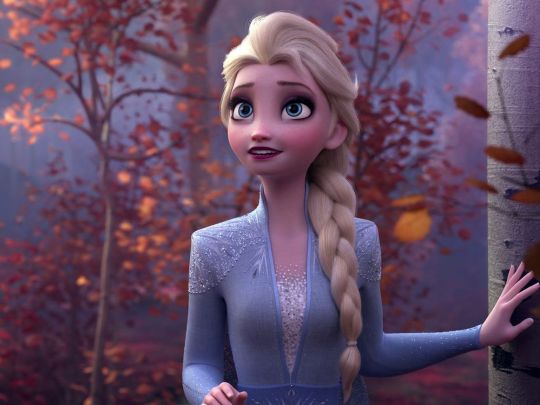
Elsa’s back. | Walt Disney Pictures
Disney used to always be looking forward. These days, it increasingly only looks back.
Nobody was more nostalgic than Marcel Proust.
The French novelist’s six-volume masterwork In Search of Lost Time is narrated by a man who’s remembering his youth, and it explores how strange and unreliable memory can be. Throughout the series, the notion of “involuntary” memory is a recurring theme, but it’s particularly important in the famous “madeleine” scene.
The scene comes early in the first volume, Swann’s Way, when the taste of a madeleine dipped in tea immediately plunges the narrator into a vivid childhood memory. It’s so well-known that it remains a cultural reference point even today, more than a century after Swann’s Way was published: To say that something is your “madeleine” is shorthand for any sensory experience that brings back a flood of childhood memories (even though mounting evidence suggests that Proust’s version may have just been soggy toast).
That sensory experiences can trigger powerful memories, particularly of youth and childhood, was not a particularly earth-shattering insight on Proust’s part — lots of people have had similar episodes. And while not all of his narrator’s recollections are fond, a lot of them seem presented through a haze of affection — the reliability of which, as the narrator us himself, is a little suspect. “Remembrance of things past is not necessarily the remembrance of things as they were,” he writes.

Maurice Rougemont/Gamma-Rapho/Getty Images
Marcel Proust famously wrote about madeleines as he explored the ways our memories are triggered.
Proust aptly describes the concept of nostalgia: a sentimental yearning for the past, which Merriam Webster defines, succinctly and evocatively, as “the state of being homesick.” And while we periodically recall certain moments as being worse than they actually were (I think of the 30 Rock episode in which Liz Lemon is shocked to discover that her memories of being bullied in high school are faulty, and she was the one doing the bullying), the past often takes on a rosy hue.
Time, distance, and the occasional dash of willful ignorance are effective modifiers. They’re why societies collectively hallucinate Golden Ages, and why so many people find the idea of making America “great again” appealing. It’s less about conserving the good of the past, and more about rejecting the present.
Nostalgia is not, as a mood, inherently bad. Sometimes, feeling a bit homesick is good. But when that feeling becomes our default posture, our guiding light, it starts to become ... troubling? Inhibiting, maybe? Stifling? If the past was when things were good, why bother to build a new future? Better to just keep reinventing the past.
Which brings us to Disney, and to Frozen 2.
Disney used to be a company that looked forward. These days, it seems more interested in looking back.
Disney now controls the lion’s share of the movie industry. In 2019 so far, five of the six highest-grossing films worldwide have been Disney properties; the sixth (Spider-Man: Far From Home) was a joint endeavor between Sony and Disney-owned Marvel. The company’s reach is staggering: It owns, among scores other entities, Pixar, the Marvel Cinematic Universe, Star Wars, and as of earlier this year, the film and TV assets formerly held by 21st Century Fox — in addition to its own extensive and much-beloved back catalog, lots of which is now available to stream via the just-launched Disney+ service.
Disney is in the entertainment business. But what it’s selling isn’t entertainment, exactly — that’s just the vehicle for its real product, and that product has shifted and morphed over time. At one time, a big part of what Disney was selling was a vision of a utopian future, as you know, if you’ve been to Tomorrowland or Epcot at Walt Disney World.
In his speech at the opening day of Disneyland in 1955, Walt Disney himself pointed to his vision of the park as a place where nostalgia and forward-looking inspiration could coexist: “Here age relives fond memories of the past, and here youth may savor the challenge and promise of the future.”
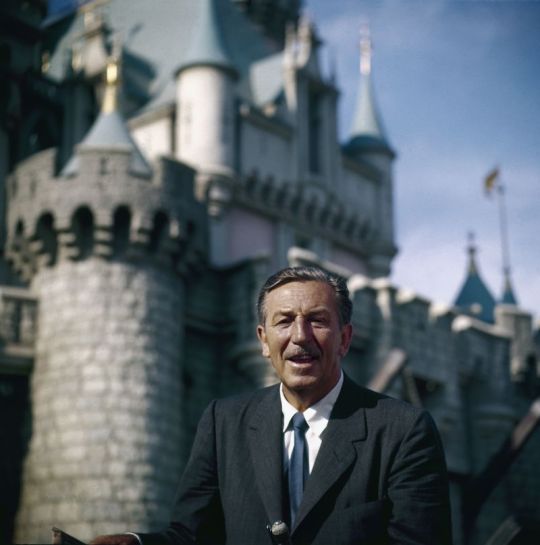
Allan Grant/The LIFE Picture Collection via Getty Images
Walt Disney at the Disneyland grand opening in 1955.
But as we come to the end of this banner year for Disney, it’s clear that what the company wants to sell us, going forward, is a seemingly infinite heap of Proustian madeleines. Certainly the warm fuzzies have been one of Disney’s main exports for a long time, but some kind of tipping point was reached in 2019. Now, it seems evident that Disney sees provoking existential homesickness as its main job. Nostalgia is its real product.
Consider Toy Story 4, the fourth film in a series that debuted in November 1995. If you were 8 years old and saw Toy Story in theaters when it opened, you might have brought your own 8-year-old to see the new film earlier this year.
That’s a remarkable stretch of time, and the Toy Story series has stayed remarkably thematically coherent over that time. It’s a set of stories about the passage of time, about how nothing stays the same, about the fact that kids grow up and leave home — that’s why Toy Story 3 left parents bawling when Andy finally grew up and didn’t need his toys anymore. The toys, in a sense, are the parents’ stand-ins. And Toy Story 4, in which some of the toys opt to live a child-free life, feels an awful lot like a movie about being an empty nester, something that could render a parent munching popcorn with their third grader a bit verklempt, thinking about their own now-empty-nester parents who once took them to see Toy Story.
That’s the good kind of nostalgia. And the Toy Story series has successfully refreshed its basic premise over two decades — toys get lost, toys get found — in part through its willingness to surprise viewers, to crack jokes and be a little creepy and think outside the (toy) box with its narratives. So when we find ourselves feeling homesick, in a story about the passage of time, it works.
I think of this approach as generative nostalgia. It’s a way for Disney to use memory, to tap into the audience’s particular madeleines, to bolster the storytelling itself (and make an enormous wad of cash, too). Not every attempt lands, but when movie studios try to tap into nostalgia in order to generate fresh new stories with universal themes, to get creative with the familiar, it’s a good thing for art.

Pixar Animation Studios / Walt Disney Pictures
From Toy Story 4, we got Forky.
If Toy Story 4 was an example of Disney harnessing generative nostalgia, however, its so-called “live-action” remake of The Lion King was just the opposite. The film was never meant to be a standalone movie; its success was always fully dependent on the long-entrenched popularity of the 1994 animated film it recreates, in some cases shot for shot. It’s an entirely unnecessary movie — a way for Disney to test-drive high-end, lifelike CGI and get people to pay for it. And without the imaginative, sometimes visually wild artwork of the original, it falls very flat, with no new perspective on its source material.
Call it derivative nostalgia: For most audiences, The Lion King and Disney’s other live-action remakes (Aladdin was another huge hit this year) are interesting only insofar as they promise to deliver a (slightly) new spin on a beloved classic, without straying too far. We still get “Can You Feel the Love Tonight,” but it’s Donald Glover and Beyoncé. A copy of the original with some of the details tweaked. That’s the appeal.
And while derivative nostalgia has its place — we rewatch our favorite movies for a reason, because we like the feelings and memories they provoke — Disney seems intent on adopting it as a modus operandi, judging from the number of remakes the company has announced. It will depend on the built-in audience of people who loved Lady and the Tramp or 101 Dalmatians to pony up for a ticket or subscribe to Disney+ and ensure these projects’ success.
But I’m convinced the urge to use your giant piles of money to endlessly replicate the past can’t be good for a culture. Certainly, human culture is cumulative; we’re always building on what came before. For millennia, storytellers have leaned on the same material, like myths and archetypes, to find new ways to tell stories. But derivative nostalgia stymies the creative impulse, miring us in the same thing over and over again and training audiences to demand the predictable. Vanilla pudding tastes good, but there’s a lot more to food than vanilla pudding.
You can witness the battle for Disney’s soul happening inside Frozen 2
These generative and derivative modes of nostalgia seem to be warring inside inside Frozen 2, which is pleasing and enjoyable even if it’s clearly designed to function as an ATM for Disney, with Frozen’s previously established fanbase acting as the bank account behind the screen. It is, thank God, no Olaf’s Frozen Adventure.
The Frozen films are aimed primarily at little girls and boys, of course — Disney’s long-running core constituency for stories about princesses and talking animals (or snowmen). But, given that the first movie came out six years ago, Frozen 2 is also for older kids. And one of the most notable things about the movie is that it’s also for their parents.
Perhaps following Pixar’s lead, the more traditional Disney Animation studio has caught onto the fact that if you want grown-ups to be happy when they take kids to the movie theater, you’ve got to make something they’ll enjoy, too. So Frozen 2 leans (more noticeably than its predecessor) into jokes the adults will appreciate, and one in particular: While the kids at my screening howled at Olaf’s slapsticky misadventures, the adults were the ones laughing as Princess Anna’s hunky boyfriend Kristoff crooned his very ’80s-sounding power ballad “Lost in the Woods.”
During a recent interview, Josh Gad (who voices Olaf) joked that the song “speaks to all of us that grew up in the ’80s.” And he’s totally right. The voice of Kristoff, Jonathan Groff, says he was surprised when the song was handed to him: “I couldn’t believe that they were going to go there,” he said, calling it “truly shocking” and later saying it has the energy of Michael Bolton. The song is about how much Kristoff needs Anna in his life; in the film, he sings it during a fantasy sequence of finding her, backed by a chorus of singing reindeer. (The official Frozen 2 soundtrack includes a version of the song by Weezer, which kind of says everything.)
As Gad pointed out, it’s definitely a sight gag for the olds in the room — the younger Gen X and older millennial parents who’ve come to see Frozen 2 with their kids, and are now being rewarded with their own extended musical joke. What’s funny about it is that the musical-style “Into the Woods” parodies was already ridiculous by the time most gen-Xers and millennials became adults; what we’re reminded of now is the sheer goofiness that was so prevalent back then, when romantic ballads were sung by guys with bad hair surrounded by unironic kitsch.
Kids born in the 21st century won’t get the joke. But Frozen 2 isn’t exclusively for them; it’s for 20th-century kids, too. In fact, though its action is set just three years after the end of Frozen, it is, like Toy Story, about the passage of time, and what it’s like to grow older. Olaf sings a song about how things don’t make sense to him now, but they will someday; Anna and Olaf reflect on how they hope everything will stay the same, even though — spoiler alert — of course, they won’t.
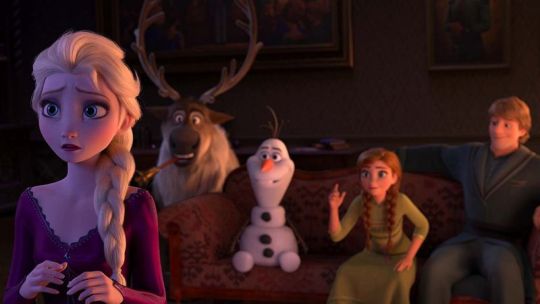
Walt Disney Pictures
The gang’s all back together in Frozen 2.
So Frozen 2 provokes all kinds of nostalgia. For kids who’ve already spent years dressing up as Anna and Elsa and driving their parents to distraction with “Let It Go,” the new film is a return to the happy land of Arendelle, where they’ve had many adventures. For teenagers who saw the original Frozen when they were 8 or so, but are now in high school, it’s a reminder of how far they’ve come. And for adults, it tugs on decades-old heartstrings — not just the chuckling memory of’ 80s power ballads, which might be the madeleine that reminds some of dancing at prom, but also the Disney princess stories so many of us grew up watching.
Whereas the original Frozen is a bit of an odd film — its plot structure feels a little out-of-sync with Disney’s usual storytelling, and its “true love’s kiss” comes not from a prince but a sister — Frozen 2 is much more conventional. Frozen retained some of the eerie strangeness of the Hans Christian Andersen fairy tale it was (very) loosely based on; Frozen 2 goes back to the usual adventure-and-return structure that has made so many classic Disney movies a success. It’s familiar. It’s comfortable.
By my lights, Frozen 2 is still a plenty enjoyable film, even if it lacks its predecessor’s subversive spark. But for me, watching generative and derivative nostalgia spar within it prompted a different sense of the familiar: bleakness about the future of mouse-eared entertainment. Disney, whatever its faults, has often been a pioneer in storytelling; now it’s resting firmly on its laurels, too often electing to spin the wheel again rather than try to reinvent it.
Nostalgia has its place. Remembering the feeling of homesickness reminds us where we came from, that we come from somewhere. But too much yearning for the past without a concomitant attempt to live in the present and push toward the future is a dangerous trap for a culture to fall into, both because it risks becoming stagnant in its art and because it may begin to to worship the past as the only place worth living in. Too much yearning for the past makes us incurious about the world. And if, as Proust wrote, the past we remember is not necessarily the one that existed, remaining stubbornly beholden to it can render us altogether incapable of dealing with the present.
The bigger Disney gets, the more it controls what most Americans — and people around the world — will see at the movies and on their TV screens, and thus it bears enormous responsibility for seeing into the future. Looking backward too much, recycling old content and relying on old formulas endlessly, becomes a snake eating its own tail.
As the endless stream of reboots and remakes and sequels and revivals that currently dominates entertainment attests, nostalgia sells. But it is also the thing most easily packaged to sell. Recycling content is the low-hanging fruit. And when Disney leans into the least creative sort of recycled content, live-action remakes — something nobody’s really asking for — it’s signaling how little it’s interested in originality.
Even when those remakes take a risk — for instance, by casting black actress Halle Bailey as Ariel in The Little Mermaid — it’s worth noting how safe the “risk” really is. Being a creative leader who celebrates inclusivity means daring to build something new, and trusting the artists to draw audiences into a new story. It doesn’t mean casting new faces in old, well-trodden roles with guaranteed built-in audiences because you’re not sure audiences will turn up otherwise. It doesn’t mean defaulting to reviving your past.
Which, ironically, is something Walt Disney was determined to keep his company from doing. As quoted in the 2007 Disney animated film Meet the Robinsons, he pushed for just the opposite: “Around here, however, we don’t look backwards for very long. We keep moving forward, opening up new doors and doing new things, because we’re curious. And curiosity keeps leading us down new paths.”
Frozen 2 opens in theaters on November 21.
from Vox - All https://ift.tt/2OvMLXf
0 notes
Text
The 10 Best Famous Storytellers and How to Become One
Storytelling is one of the oldest forms of conveying our history. Since the beginning of time, we really haven’t changed much.
From cutting-edge CEOs like Richard Branson, who gathers his team around a fire to swap stories, to motivational speaker Tony Robbins, whose stories have inspired thousands to become their best selves – throughout history, storytelling has ignited our spirit to reach higher.
Storytellers can not only inspire us and motivate us. They can educate us, create movements, and help us to open our minds to all of the possibilities that life has to offer.
The greatest storytellers simplify. Richard Branson once said, “If your pitch can’t fit on the back of an envelope, it’s rubbish.” Business leaders like Bill and Melinda Gates are experts at explaining complex subjects using simple words.
Effective communicators simplify the story and craft their message in words that are so simple, an elementary school student can understand.
Great brands and growing businesses all have great storytellers behind their success. They have to tell their authentic, compelling stories to build the relationships that carry them to success.
Every great relationship, brand, and business has to be built on trust, and the power of a great story can build the foundation.
What Is Storytelling?
Storytelling describes a form of human expression where stories are shared with an audience for educational purposes, for entertainment, to impart moral values, or to achieve cultural preservation.
There are so many ways storytelling can be used, which is why most storytelling, at its core, is used to encourage a listener’s imagination using words and actions. Storytelling helps to unite people as they identify with each other based on common human experiences.
via GIPHY
This means that storytelling can be used in marketing, and when it is done right, it can be highly effective! Marketers can use storytelling to truly connect with their target audience.
In marketing, it isn’t about the product or service. It’s about how you can weave your offerings into the story of the customer’s life.
For instance, Subaru often communicates “love” in their marketing ads to describe the way the brand fits into customers’ lives. They tell a story of how giving your child, wife, sister, or brother a car is loving because of Subaru’s awesome safety features.
Why Marketers Need to Learn Storytelling
Here are some reasons why marketers should use storytelling in their marketing messages:
Stories Help to Create Memories.
Hearing a good story helps people to remember information whether they recognize it or not.
This means that when an audience hears a story, their brain creates images, they feel emotions, and they hear sounds. This psychologically allows them to remember what you are telling them better than if you simply told them the facts about your products.
via GIPHY
Sometimes marketers don’t even need their audience to listen actively. The stories will stick to the audience anyway when they are told effectively.
Stories Engage Customers and Keep Them Interested.
Aggressive advertising messages hurt business, whereas storytelling helps business by keeping customers engaged and interested. This is because storytelling sparks emotions that regular advertising does not.
Touching your customers feelings also influences them to engage with your brand. When customers feel like they can be a part of the positive story you told by buying your products or services, or by engaging with your brand on social media, then they will be more likely to remain loyal to your brand.
They may also tell their friends and family about your brand and submit good reviews just because you provided them with a great story.
Great Stories Make Great Content.
Have you ever thought about why content is king? It is king because people love stories.
They like watching videos, reading blogs, and consuming other content because it gives them an exciting experience. Through these exciting experiences, they remember your brand name.
The stories you tell can be woven into all of your content. And if your content marketing contains enough interesting stories, then the more likely your audience is to link things in their life with your brand.
Storytelling Is a Powerful Form of Learning.
Since storytelling helps people remember information better, it also helps us to learn. They transmit knowledge and meaning.
via GIPHY
Other than telling stories, marketers should also listen to stories to learn more about their audience. This helps them to understand what is going on in the marketplace so they can craft messages that help your products or services fit into those stories in a meaningful way.
How to Become a Great Storyteller
Some people are natural storytellers, but others need a little bit of help. If you need some help cultivating the art of storytelling, here are five steps you can take to help you become a great storyteller.
via GIPHY
1. Plan Out Your Story and Write It Down.
If you want to tell your story aloud to an audience, it may be a good practice to write out what you are going to say. This doesn’t mean that you have to write out everything you will say word for word.
Instead, you can plan and organize your talking points into an outline.
Use your talking points as a reference and then ad-lib the other parts of your story to make your story seem natural like you are having a conversation. When storytelling flows naturally, it helps create a greater connection between you and your audience.
2. Make Your Story Personal.
People will invest more into your story when you add your personal touch to it. Talk about your personal experience as it relates to your storytelling topic, and your audience will be more likely to care about what you are saying.
For instance, a speaker may talk about how they had an experience with unclean drinking water as a child to link to the reasons why they promote clean water initiatives now.
3. Understand Who Your Target Audience Is.
Your story should be adapted based on your audience. The story should be personal, but it should also resonate well with the audience you are speaking to or writing content for.
For instance, your story will change when you are talking to investors versus when you talk to your customers because they are interested in different outcomes.
4. Sprinkle Your Main Points Throughout the Story.
Don’t use all your main points at the beginning of your story.
If you don’t use your main points throughout your story, you will lose your audience. Keep them interested by providing them with main points at the right time to pace your story well.
5. Leave Room For Surprises.
The best storytellers don’t want their audience to know exactly what to expect. This means you must hold back some of your most pertinent information to surprise the audience with awesome information later on.
As your story unfolds, throw a plot twist into your story to recapture your audience’s attention.
To help you understand storytelling better, let’s take a closer look at some of the best storytellers of all time. Study what they do, and try to develop your storytelling strategy based on some of their best skills.
The 10 Best Storytellers of All Time
Here are 10 of the greatest storytellers of all time and what we can learn from their stories:
1. Anita Roddick
Although she’s gone now, Anita Roddick was one of the greatest storytellers in business. She built the Body Shop on a great story and inspired millions through the stories behind her products, its support against animal testing, her belief in basic human rights, ethical trading, the arts, and the environment.
In one of her last interviews with the Daily Telegraph, she said, “One of the most intriguing things in management and in business is the role of storytelling – people need the anecdotes to do the work they do.”
She was a great archivist, and she took the history of the Body Shop and created the stories that grew her brand, shaped its strategy, and identified what made her organization great.
From her, we learn that our history is who we are. Telling the stories of our values, our successes, and our failures can influence the direction of our business and build a brand.
2. Walt Disney
Whether you’re watching one of his films or visiting his theme parks, Walt Disney told stories that transcended age to create experiences that immersed people in his fantastic worlds.
Disney understood that creating an unforgettable experience meant focusing on the minute details and how those details contributed to the full story.
via GIPHY
What we can take away from Disney’s magic is that using details can create an immersive experience. Just make sure that the details don’t detract form the story you’re trying to tell.
3. Richard Branson
Richard Branson is one of the richest and most powerful men in the world.
He got that way by never shying away from a conversation and an opportunity to tell stories about the remarkable moments of his life and the lives of others.
He freely shares what he thinks, what he has seen, and what he does. That openness is reflected in the Virgin brand. He understands the power of nuance, even if it’s not polished, that makes a story captivating.
The takeaway? The flaws are what make your stories interesting and memorable. Don’t polish every detail: Just tell your story, flaws and all.
4. Bruce Springsteen
For decades, “The Boss” has painted pictures of the American experience through his songs.
Great stories have villains and heroes, they have conflict, happy endings and sad endings, and sometimes, no ending at all.
The stories Bruce Springsteen tells are often inspires by the stories of other people. His multi-platinum hit “The River” was said to be inspired by his sister’s relationship.
via GIPHY
Because his stories are so deeply personal, they have the ability to draw you into the song as a character living the experience. His talent is making the listener feel like their story is communal – a shared history, and that makes you feel less alone.
Great storytelling brings us together by touching us on an emotional level and creating a shared experience that makes us feel like a part of something bigger. By framing your story in an emotionally inclusive way, you can work to build your tribe.
5. Steve Jobs
Steve Jobs is a must on any list of storytellers. His entire career was based on stories.
He understood that his products didn’t just need customers; they needed disciples who would tell his story as if it was their own to move his business forward. And that’s what made Apple.
The best storytellers get others to tell their stories for them. In order to do that, the stories need to be recallable and motivated.
If your stories have emotional impact, resonate with the listener, and are relevant (which comes out in the details – see Walt Disney above), your listeners will do most of the work for you.
The lesson? Create an experience worth sharing if you want your story to spread. It has to be memorable and backed up by the facts (e.g., your product) to resonate and be effective.
6. Sheryl Sandberg
Through her own personal anecdotes, the COO of Facebook and author of Lean In uses her position to address common problems that men and women face today.
Her stories are ones that we can all relate to. By tapping into her personal experiences, ones that are sometimes surprising to hear from someone so powerful, she generates empathy with her listeners, empowering them to reach new heights.
The takeaway? Sharing personal stories can make you feel vulnerable, but your vulnerability is what truly resonates with listeners. It’s the tie that connects us all.
7. Tony Robbins
Tony Robbins built his career on his ability to tell a story.
His passionate story of his humble beginnings, “…living in a 400-square foot apartment and washing his dishes in the bathtub,” is something almost all of us can relate to.
via GIPHY
Remember those first years on your own after college? His inspirational story of how he built his company and his life to the point where nothing is impossible is inspirational and has lit the fire of change for thousands of listeners from all over the world.
We all have a story. Even if uninspiring, it is still being written. With creativity and drive, anything is possible. Robbins’ stories work because we’re wired to root for the underdog. Struggle is a part of life, and we find stories of triumph over the odds inspirational.
8. Oprah Winfrey
Oprah is possibly one of the most well-known talk show hosts of all time. She has inspired millions with her stories and interviews.
Her story began with humble beginnings and hardship. A classic rags to riches story with some hard work and tons of accomplishments along the way.
She also believes in the power of storytelling and is quite good at helping other people tell their stories as well.
Her show became a place for people of various backgrounds and social statuses to recount and discuss their stories, along with a variety of social causes and issues.
The takeaway is that being a great storyteller helps to encourage others to tell their stories too. This helps to bring more ideas to light, which opens up a world full of possibilities.
9. Elon Musk
CEO of SpaceX and Tesla, Elon Musk is an effective storyteller who has inspired and affected great change in his industry. He has effectively convinced investors to contribute high amounts of money into risky endeavors. This is due to his drive and his belief in his business ideas.
He is able to explain his high-concept ideas in a simple way that helps to engage his audience and spark imagination.
You can learn a few things from Elon Musk’s simplicity when you explain complex ideas to your audience. If you understand something well, you can explain it in a way that other people can understand too.
10. Stephen King
Stephen King is an iconic writer and storyteller. He is a master of suspense, and not only can he write best-selling stories, he can tell great stories orally as well.
In his talks, he emphasizes his need to write more than he does anything else, and how being a good writer mostly starts with reading great stories. King also tells the interesting story of his life that shaped him into the successful author he is today.
via GIPHY
He never let the critics get to him and he continued to do what he was passionate about and shared his love of storytelling with others.
Today, we’re bombarded with choices. Who we do business with often comes down to who tells the most compelling, honest story.
Having a good story can define your brand, explain your history, provide the listener with a better understanding of your values, and help you to grow your business.
In the business world, the most successful companies have the most compelling stories. Storytellers are all around us. It’s time for you to share your story with unflinching honesty, warts and all!
The 10 Best Famous Storytellers and How to Become One published first on https://wabusinessapi.tumblr.com/
0 notes
Text
Sensor Sweep: Firefly, Lou Antonelli, Nintendo 1985, Robot Anime
T.V. (Medium.com): Every generation has their white whale of a concluded series. Baby boomers got hooked on Star Trek and made a big noise about it until they got movies, spinoff shows, more movies, more spinoff shows… Generation X kept the love of Star Wars alive until they got novels, video games, comics and, err, prequels. Milennials got Firefly. And three years later, Serenity, a movie that, while excellent, reminded us that the story worked better on TV. And then nothing.
Author Interview (Liberty Island): It was four months of Hell for the Sad Puppy finalists– from the announcement of the ballot in April until the WorldCon in August – and essentially a left-wing lynch mob. In the end, the whole fiasco can be considered useful because it made the secret manipulators come out of the closet. Larry Correia has been completely vindicated.
Fiction (Paperback Warrior): “East of Desolation” was Jack Higgins’ (real name: Henry Patterson) 22nd novel, published in 1968 by Berkley and then reprinted dozens of times using different cover art. The book arrived seven years prior to Higgins becoming a mega-bestseller and household name with his 1975 novel “The Eagle Has Landed”. While booming sales never supported the material, the 1960s produced some of Higgins’ finest literary work, evident with this ice-capped adventure starring brush pilot Joe Martin.
Westerns (Mostly Old Books): A taut and violent short western that finds young Jess Remsberg, consumed with avenging the rape and murder of his wife, scouting for an Army wagon train that finds itself outnumbered in a brutal cat-and-mouse battle with a band of merciless Apaches. The tension remains high as the brilliant Apache warlord Chata matches wits step for step with young and ambitious Army Lieutenant McAllister who is close friends with Jess.
Book Review (Pulp Fiction Reviews): New Pulp writer Derrick Ferguson is best known for his action packed adventures, be they the exploits of Dillon, Fortune McCall or Sebastian Red. All of these should already be on your reading list. But back in 1914, Ferguson wrote this truly amazing novella, “The Madness of Frankenstein” that is his homage to the great Hammer horror flicks of the 60s and 70s. Having finally picked up a copy, we were eager open its pages and discover what special grisly treats Mr. Ferguson had whipped up for his unsuspecting readers.
Cinema (Scifi Movie Page): Disney+ has officially arrived, with all the force and weight that Uncle Walt’s 600 lb. entertainment gorilla can muster. The Mouse plays for keeps, and the buzz around event releases like The Mandalorian and the various MCU projects immediately put their streaming service in the top tier alongside Netflix and Amazon.
But Disney’s strengths go beyond their acquisition (and undeniably strong shepherding) of hot IPs such as Marvel and Star Wars. Their library stretches back over 80 years, and a large amount of it is available for streaming.
D&D (Walker’s Retreat): You know you’ve got something worth watching when you get a comment like this: “Yes. Monotheism is the missing link that D&D needs for a medieval authentic feeling in your game. I use it. In addition it does one of two things. It either keeps SJWs away from your game, or it attracts them because they want to break your game or be an antichurch outsider. In those cases they always end up quitting because they don’t get what they want.”
Gaming (RMWC Reviews): The Nintendo Entertainment System represented a sea change in what video game consoles could do and how they were received at home. Released in 1985 in North America, the NES came out at a time when the American market was still reeling from the great industry crash of 1983. Compared to the Atari 2600 which was the previous home console of choice, the NES had better graphics, sound, processing power, and yes, gimmicks. The 1985 launch was actually limited to New York City for the holiday season, and was then expanded in 1986 when it was clear to be a success.
Anime (Wasteland and Sky): As anyone who knows anime knows, there are two kinds of mecha series. First there were the originals, the super robots, then there were those created with Mobile Suit Gundam, the real robots. The former were pulp heroes that went on adventures to stop the villains while the latter were based on soldiers fighting in wars. Different approaches and aims allowed for very different legacies.
Book Review (Matthew Constantine): The second book in The Prydain Chronicles by Lloyd Alexander, The Black Cauldron is somewhat more complex and more interesting than The Book of Three. Having already been introduced to many of the characters, we don’t need to go through that again and can instead jump right into the action. Taran and friends are tasked with finding and destroying the Black Cauldron aka the Crochan, the magic item used to create near invincible Cauldron Born, undead warriors.
Tolkien (BBC): A pub made famous as a meeting place for fantasy authors CS Lewis and JRR Tolkien is to be made into a hotel. The Eagle and Child in St Giles’, Oxford, has a plaque inside commemorating the writers’ get-togethers. Known as The Inklings, they would regularly meet up with other academics at the Grade II listed pub. The application was approved by Oxford City Council’s west area planning committee on Tuesday.
D&D/Cinema (Tenkar’s Tavern): Comicbook.com shared an article about the upcoming Dungeons & Dragons movie (due Summer of 2021) – Thanks to Luke Gygax for sharing the article on Facebook. The upcoming Dungeons & Dragons movie will feature at least one character with ties to the Forgotten Realms and will focus on a quest for an iconic magical object. ComicBook.com can exclusively report that the upcoming Dungeons & Dragons movie currently in development by Paramount will focus on a group of adventurers looking for the Eye of Vecna, a powerful artifact that dates back to the earliest days of the game.
Pulp Hero (Black Gate): I have to confess that writing The Spider is a completely different experience for me than writing the Wild Adventures of Doc Savage, Tarzan, John Carter, or any of the other classic pulp heroes I’ve been privileged to bring back to life in new novels. With these other pulp heroes, it’s largely a matter of concocting a logical plot and having the heroes go through their customary pieces, although I seem to have quickly become an accidental king of crossovers since I’ve managed to convince the various license holders to permit me to have a few of them collide, such as Doc Savage and The Shadow, Tarzan of the Apes and King Kong.
Review (Porpor Books Blog): Men of Violence: All Review Special’ ($5.99, 93 pp) features reviews (limited to 250 words for an individual book and 500 words for a series) of over 100 paperbacks and comics published from 1953 to the present day, that fall (more or less) into the genre of ‘Men’s Adventure’ fiction. Needless to say, we live in an era in which men rarely read for pleasure, the genre of Men’s Adventure is regarded as affront to a Woke society, and any adolescent who brings a copy of Torture Love Cage (Jack Savage, 1959) to school probably will be expelled, and obliged to receive Counseling before being readmitted.
Book Review (Rough Edges): Almost a year ago, I read the first book in the Casca series by Barry Sadler and really enjoyed it. I didn’t mean for so much time to go by before I got back to the series, but that’s the way it happened. I’ve finally read the second book, GOD OF DEATH, which picks up the story of Casca Rufio Longinus, former Roman soldier who was present at the Crucifixion and was cursed with immortality because of it. Wounds or illness that would kill a normal man can’t claim him, and he’s doomed to wander the world, always making his way as a mercenary soldier.
Novel Excerpt (DMR Books): Wulfhere and Eanhere and their army of bears crept down the valley silently. From a cliff they could see Penda’s men as they sat in a little grove eating their midday meal. Eanhere took half the bears and crept round to the other side of the grove while Wulfhere waited on this side with the rest. Wulfhere crept quietly closer till only a small knoll stood between the Mercians and himself, and he could hear their loud talk and laughter. “Ha, we will root this bear out of his den, and he will go the way of his people!” one said as he emptied his horn of mead.
Art (Karavansara): Turns out this is a Robert Maguire cover for a novel called The Deadly Lady of Madagascar, bt Frank G. Slaughter (nice name for someone writing about deadly ladies) that I will try and find somehow. If I can’t write it, I can certainly read it.
Alt. History (Enter Stage Right): Alternative history (popularly called “alternate history”) is sometimes termed “uchronia” or counterfactual history. It is important to remember that alternative history pertains to events that are in the past at the time when the narrative is being written. So, for example, the 1920s projections of Hugo Gernsback about the 1980s cannot be properly termed as being alternative history – even though his vision of the world of the 1980s is much different from what has actually occurred.
D&D (Sacnoth’s Scriptorium): So, I just got a comment on my post back in September on the new film documenting Arnesom’s role in the creation of D&D. Since the comment seems to come from the filmmaker himself, thought I’d feature it here so as to give the filmmakers a better chance to have their say. Here’s their comment.
Gaming Magazines (Silver Key): Later issues of White Dwarf introduced readers to Thrud the Barbarian. The loinclothed barbarian stereotype born in the pages of sword-and-sorcery (Brak, Thongor, Kothar and their ilk) was by then quite pervasive, and strip author Carl Critchlow had fun with a character that was literally all muscle and no brain—a tiny head upon a massive, muscular body. Issue #50 (February 1984) has Thrud invoking “the sacred jockstrap of Robert E. Howard” before hacking his way through a horde of castle defenders, whom he (mistakenly) believes are holding a princess captive in the tower.
Science Fiction (Tellers of Weird Tales): I’m going back farther now into the past, into spring when, in a week when I was sick, I read The Space Trilogy by C.S. Lewis. Things To Come (1936) was still fresh in my mind when I read these books. That freshness may have influenced my thoughts on Out of the Silent Planet (1938), Perelandra (1943), and That Hideous Strength (1945). I shouldn’t spend too much time on this, but I’m sure I will. There is a lot in The Space Trilogy and it’s hard to move past some of these things without commenting on them and applying them to issues current in this blog and in our world of today.
Weird Tales (Dark Worlds Quarterly): Seabury Grandin Quinn would begin his writing career in The Thrill Book, an early Weird Tales precursor devoted to strange and off-trail fiction. Street & Smith, the future publisher of The Phantom and Doc Savage, ran The Thrill Book for sixteen issues, from March 1 to October 15, 1919. The magazine would publish Francis Stevens’ The Heads of Cerberus, one of the first science fiction novels about parallel worlds.
Sensor Sweep: Firefly, Lou Antonelli, Nintendo 1985, Robot Anime published first on https://sixchexus.weebly.com/
0 notes
Text
On Frozen 2 and Disney’s nostalgia problem
Elsa’s back. | Walt Disney Pictures
Disney used to always be looking forward. These days, it increasingly only looks back.
Nobody was more nostalgic than Marcel Proust.
The French novelist’s six-volume masterwork In Search of Lost Time is narrated by a man who’s remembering his youth, and it explores how strange and unreliable memory can be. Throughout the series, the notion of “involuntary” memory is a recurring theme, but it’s particularly important in the famous “madeleine” scene.
The scene comes early in the first volume, Swann’s Way, when the taste of a madeleine dipped in tea immediately plunges the narrator into a vivid childhood memory. It’s so well-known that it remains a cultural reference point even today, more than a century after Swann’s Way was published: To say that something is your “madeleine” is shorthand for any sensory experience that brings back a flood of childhood memories (even though mounting evidence suggests that Proust’s version may have just been soggy toast).
That sensory experiences can trigger powerful memories, particularly of youth and childhood, was not a particularly earth-shattering insight on Proust’s part — lots of people have had similar episodes. And while not all of his narrator’s recollections are fond, a lot of them seem presented through a haze of affection — the reliability of which, as the narrator us himself, is a little suspect. “Remembrance of things past is not necessarily the remembrance of things as they were,” he writes.
Maurice Rougemont/Gamma-Rapho/Getty Images
Marcel Proust famously wrote about madeleines as he explored the ways our memories are triggered.
Proust aptly describes the concept of nostalgia: a sentimental yearning for the past, which Merriam Webster defines, succinctly and evocatively, as “the state of being homesick.” And while we periodically recall certain moments as being worse than they actually were (I think of the 30 Rock episode in which Liz Lemon is shocked to discover that her memories of being bullied in high school are faulty, and she was the one doing the bullying), the past often takes on a rosy hue.
Time, distance, and the occasional dash of willful ignorance are effective modifiers. They’re why societies collectively hallucinate Golden Ages, and why so many people find the idea of making America “great again” appealing. It’s less about conserving the good of the past, and more about rejecting the present.
Nostalgia is not, as a mood, inherently bad. Sometimes, feeling a bit homesick is good. But when that feeling becomes our default posture, our guiding light, it starts to become ... troubling? Inhibiting, maybe? Stifling? If the past was when things were good, why bother to build a new future? Better to just keep reinventing the past.
Which brings us to Disney, and to Frozen 2.
Disney used to be a company that looked forward. These days, it seems more interested in looking back.
Disney now controls the lion’s share of the movie industry. In 2019 so far, five of the six highest-grossing films worldwide have been Disney properties; the sixth (Spider-Man: Far From Home) was a joint endeavor between Sony and Disney-owned Marvel. The company’s reach is staggering: It owns, among scores other entities, Pixar, the Marvel Cinematic Universe, Star Wars, and as of earlier this year, the film and TV assets formerly held by 21st Century Fox — in addition to its own extensive and much-beloved back catalog, lots of which is now available to stream via the just-launched Disney+ service.
Disney is in the entertainment business. But what it’s selling isn’t entertainment, exactly — that’s just the vehicle for its real product, and that product has shifted and morphed over time. At one time, a big part of what Disney was selling was a vision of a utopian future, as you know, if you’ve been to Tomorrowland or Epcot at Walt Disney World.
In his speech at the opening day of Disneyland in 1955, Walt Disney himself pointed to his vision of the park as a place where nostalgia and forward-looking inspiration could coexist: “Here age relives fond memories of the past, and here youth may savor the challenge and promise of the future.”
Allan Grant/The LIFE Picture Collection via Getty Images
Walt Disney at the Disneyland grand opening in 1955.
But as we come to the end of this banner year for Disney, it’s clear that what the company wants to sell us, going forward, is a seemingly infinite heap of Proustian madeleines. Certainly the warm fuzzies have been one of Disney’s main exports for a long time, but some kind of tipping point was reached in 2019. Now, it seems evident that Disney sees provoking existential homesickness as its main job. Nostalgia is its real product.
Consider Toy Story 4, the fourth film in a series that debuted in November 1995. If you were 8 years old and saw Toy Story in theaters when it opened, you might have brought your own 8-year-old to see the new film earlier this year.
That’s a remarkable stretch of time, and the Toy Story series has stayed remarkably thematically coherent over that time. It’s a set of stories about the passage of time, about how nothing stays the same, about the fact that kids grow up and leave home — that’s why Toy Story 3 left parents bawling when Andy finally grew up and didn’t need his toys anymore. The toys, in a sense, are the parents’ stand-ins. And Toy Story 4, in which some of the toys opt to live a child-free life, feels an awful lot like a movie about being an empty nester, something that could render a parent munching popcorn with their third grader a bit verklempt, thinking about their own now-empty-nester parents who once took them to see Toy Story.
That’s the good kind of nostalgia. And the Toy Story series has successfully refreshed its basic premise over two decades — toys get lost, toys get found — in part through its willingness to surprise viewers, to crack jokes and be a little creepy and think outside the (toy) box with its narratives. So when we find ourselves feeling homesick, in a story about the passage of time, it works.
I think of this approach as generative nostalgia. It’s a way for Disney to use memory, to tap into the audience’s particular madeleines, to bolster the storytelling itself (and make an enormous wad of cash, too). Not every attempt lands, but when movie studios try to tap into nostalgia in order to generate fresh new stories with universal themes, to get creative with the familiar, it’s a good thing for art.
Pixar Animation Studios / Walt Disney Pictures
From Toy Story 4, we got Forky.
If Toy Story 4 was an example of Disney harnessing generative nostalgia, however, its so-called “live-action” remake of The Lion King was just the opposite. The film was never meant to be a standalone movie; its success was always fully dependent on the long-entrenched popularity of the 1994 animated film it recreates, in some cases shot for shot. It’s an entirely unnecessary movie — a way for Disney to test-drive high-end, lifelike CGI and get people to pay for it. And without the imaginative, sometimes visually wild artwork of the original, it falls very flat, with no new perspective on its source material.
Call it derivative nostalgia: For most audiences, The Lion King and Disney’s other live-action remakes (Aladdin was another huge hit this year) are interesting only insofar as they promise to deliver a (slightly) new spin on a beloved classic, without straying too far. We still get “Can You Feel the Love Tonight,” but it’s Donald Glover and Beyoncé. A copy of the original with some of the details tweaked. That’s the appeal.
And while derivative nostalgia has its place — we rewatch our favorite movies for a reason, because we like the feelings and memories they provoke — Disney seems intent on adopting it as a modus operandi, judging from the number of remakes the company has announced. It will depend on the built-in audience of people who loved Lady and the Tramp or 101 Dalmatians to pony up for a ticket or subscribe to Disney+ and ensure these projects’ success.
But I’m convinced the urge to use your giant piles of money to endlessly replicate the past can’t be good for a culture. Certainly, human culture is cumulative; we’re always building on what came before. For millennia, storytellers have leaned on the same material, like myths and archetypes, to find new ways to tell stories. But derivative nostalgia stymies the creative impulse, miring us in the same thing over and over again and training audiences to demand the predictable. Vanilla pudding tastes good, but there’s a lot more to food than vanilla pudding.
You can witness the battle for Disney’s soul happening inside Frozen 2
These generative and derivative modes of nostalgia seem to be warring inside inside Frozen 2, which is pleasing and enjoyable even if it’s clearly designed to function as an ATM for Disney, with Frozen’s previously established fanbase acting as the bank account behind the screen. It is, thank God, no Olaf’s Frozen Adventure.
The Frozen films are aimed primarily at little girls and boys, of course — Disney’s long-running core constituency for stories about princesses and talking animals (or snowmen). But, given that the first movie came out six years ago, Frozen 2 is also for older kids. And one of the most notable things about the movie is that it’s also for their parents.
Perhaps following Pixar’s lead, the more traditional Disney Animation studio has caught onto the fact that if you want grown-ups to be happy when they take kids to the movie theater, you’ve got to make something they’ll enjoy, too. So Frozen 2 leans (more noticeably than its predecessor) into jokes the adults will appreciate, and one in particular: While the kids at my screening howled at Olaf’s slapsticky misadventures, the adults were the ones laughing as Princess Anna’s hunky boyfriend Kristoff crooned his very ’80s-sounding power ballad “Lost in the Woods.”
During a recent interview, Josh Gad (who voices Olaf) joked that the song “speaks to all of us that grew up in the ’80s.” And he’s totally right. The voice of Kristoff, Jonathan Groff, says he was surprised when the song was handed to him: “I couldn’t believe that they were going to go there,” he said, calling it “truly shocking” and later saying it has the energy of Michael Bolton. The song is about how much Kristoff needs Anna in his life; in the film, he sings it during a fantasy sequence of finding her, backed by a chorus of singing reindeer. (The official Frozen 2 soundtrack includes a version of the song by Weezer, which kind of says everything.)
As Gad pointed out, it’s definitely a sight gag for the olds in the room — the younger Gen X and older millennial parents who’ve come to see Frozen 2 with their kids, and are now being rewarded with their own extended musical joke. What’s funny about it is that the musical-style “Into the Woods” parodies was already ridiculous by the time most gen-Xers and millennials became adults; what we’re reminded of now is the sheer goofiness that was so prevalent back then, when romantic ballads were sung by guys with bad hair surrounded by unironic kitsch.
Kids born in the 21st century won’t get the joke. But Frozen 2 isn’t exclusively for them; it’s for 20th-century kids, too. In fact, though its action is set just three years after the end of Frozen, it is, like Toy Story, about the passage of time, and what it’s like to grow older. Olaf sings a song about how things don’t make sense to him now, but they will someday; Anna and Olaf reflect on how they hope everything will stay the same, even though — spoiler alert — of course, they won’t.
Walt Disney Pictures
The gang’s all back together in Frozen 2.
So Frozen 2 provokes all kinds of nostalgia. For kids who’ve already spent years dressing up as Anna and Elsa and driving their parents to distraction with “Let It Go,” the new film is a return to the happy land of Arendelle, where they’ve had many adventures. For teenagers who saw the original Frozen when they were 8 or so, but are now in high school, it’s a reminder of how far they’ve come. And for adults, it tugs on decades-old heartstrings — not just the chuckling memory of’ 80s power ballads, which might be the madeleine that reminds some of dancing at prom, but also the Disney princess stories so many of us grew up watching.
Whereas the original Frozen is a bit of an odd film — its plot structure feels a little out-of-sync with Disney’s usual storytelling, and its “true love’s kiss” comes not from a prince but a sister — Frozen 2 is much more conventional. Frozen retained some of the eerie strangeness of the Hans Christian Andersen fairy tale it was (very) loosely based on; Frozen 2 goes back to the usual adventure-and-return structure that has made so many classic Disney movies a success. It’s familiar. It’s comfortable.
By my lights, Frozen 2 is still a plenty enjoyable film, even if it lacks its predecessor’s subversive spark. But for me, watching generative and derivative nostalgia spar within it prompted a different sense of the familiar: bleakness about the future of mouse-eared entertainment. Disney, whatever its faults, has often been a pioneer in storytelling; now it’s resting firmly on its laurels, too often electing to spin the wheel again rather than try to reinvent it.
Nostalgia has its place. Remembering the feeling of homesickness reminds us where we came from, that we come from somewhere. But too much yearning for the past without a concomitant attempt to live in the present and push toward the future is a dangerous trap for a culture to fall into, both because it risks becoming stagnant in its art and because it may begin to to worship the past as the only place worth living in. Too much yearning for the past makes us incurious about the world. And if, as Proust wrote, the past we remember is not necessarily the one that existed, remaining stubbornly beholden to it can render us altogether incapable of dealing with the present.
The bigger Disney gets, the more it controls what most Americans — and people around the world — will see at the movies and on their TV screens, and thus it bears enormous responsibility for seeing into the future. Looking backward too much, recycling old content and relying on old formulas endlessly, becomes a snake eating its own tail.
As the endless stream of reboots and remakes and sequels and revivals that currently dominates entertainment attests, nostalgia sells. But it is also the thing most easily packaged to sell. Recycling content is the low-hanging fruit. And when Disney leans into the least creative sort of recycled content, live-action remakes — something nobody’s really asking for — it’s signaling how little it’s interested in originality.
Even when those remakes take a risk — for instance, by casting black actress Halle Bailey as Ariel in The Little Mermaid — it’s worth noting how safe the “risk” really is. Being a creative leader who celebrates inclusivity means daring to build something new, and trusting the artists to draw audiences into a new story. It doesn’t mean casting new faces in old, well-trodden roles with guaranteed built-in audiences because you’re not sure audiences will turn up otherwise. It doesn’t mean defaulting to reviving your past.
Which, ironically, is something Walt Disney was determined to keep his company from doing. As quoted in the 2007 Disney animated film Meet the Robinsons, he pushed for just the opposite: “Around here, however, we don’t look backwards for very long. We keep moving forward, opening up new doors and doing new things, because we’re curious. And curiosity keeps leading us down new paths.”
Frozen 2 opens in theaters on November 21.
from Vox - All https://ift.tt/2OvMLXf
0 notes